
BRD has an expert team of high qualified analysts and international professionals.
Our Study and Research Department conductes highly efficient analysis, studies and business documentations.
Our service spectrum incude the following:
Study, research and consultancy for the support and structure of updated regulations, statistical, legal and economic aid of all servicesand areas within the competence of the company;
Daily updated "press review";
Analysis focused on specific issues or current problems which seek to optimize the whole service spectrum.
Pop store, temporary & street food

Download the research:
Pop store, temporary & street food
To learn more: This email address is being protected from spambots. You need JavaScript enabled to view it.
Analisi di mercato Fonte Nuova (RM) - 06/06/2015
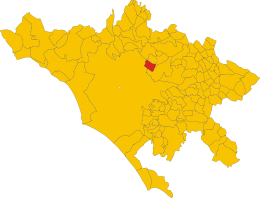
Download the research:
Analisi di mercato Fonte Nuova (RM)
To learn more: This email address is being protected from spambots. You need JavaScript enabled to view it.
Sviluppo di una catena di fast food di prodotti italiani di qualità in UK-2013

Download the research:
Ricerca di mercato UK
To learn more: This email address is being protected from spambots. You need JavaScript enabled to view it.
Analisi comparativa consumi Oil/Non Oil in Italia 2013/14

Download the research:
Non Oil Focus Market Study 2013/14
To learn more: This email address is being protected from spambots. You need JavaScript enabled to view it.
Analisi di mercato Agroalimentare in Italia 2013/14

Download the research:
Analisi di mercato Agroalimentare in Italia 2013/14
To learn more: This email address is being protected from spambots. You need JavaScript enabled to view it.
Ricerca di mercato Ipotesi Polo Commerciale
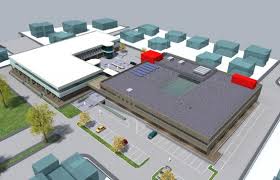
Download the research:
Ricerca di mercato Ipotesi Polo Commerciale
To learn more: This email address is being protected from spambots. You need JavaScript enabled to view it.
Decine di milioni di euro complessivi: sono state ben 688 le iniziative finanziate!!!!
Dal 2003 al 2010 INVITALIA, l'agenzia governativa per l'attrazione degli investimenti e lo sviluppo d'impresa ha finanziato la misura del Franchising ... per contrastare la crisi dei consumi e sostenere lo sviluppo della nuova imprenditorialità... una tentazione in ascesa in Italia.
L'obiettivo è coinvolgere giovani, donne e persone non occupate interessate ad avviare un percorso imprenditoriale... sviluppare la rete di vendita di un franchisor appoggiando il desiderio di chi desidera mettersi in proprio, sfruttando tale opportunità.
Ma al tempo stesso sicuramente un valido aiuto per le aziende franchisor in grado di ottenere l’accredito.
To learn more:
Il Franchising Incentiva il Lavoro
Analisi di mercato Discount Centro Italia

Download the research:
Analisi di mercato Discount Centro Italia
To learn more: This email address is being protected from spambots. You need JavaScript enabled to view it.
Analisi di mercato Progetto Parcheggi Roma

Download the research:
Analisi di mercato Progetto Parcheggi Roma
To learn more: This email address is being protected from spambots. You need JavaScript enabled to view it.
Indagine di mercato panetteria Roma

Download the research:
Indagine di mercato panetteria Roma
To learn more: This email address is being protected from spambots. You need JavaScript enabled to view it.
Studio di fattibilità settore farmaceutico

Download the research:
Studio di fattibilità settore farmaceutico
To learn more: This email address is being protected from spambots. You need JavaScript enabled to view it.
Why Mexico
Per tutte le aziende e gli operatori che ci hanno chiesto maggiori informazioni sulla fiera di Mexico city...
Ecco una ricerca di mercato puntuale svolta dalla nostra sister company messicana!
Buone riflessioni e vi aspettiamo …numerosi !!!!
Download the research:
Presentacion Why Mexico
To learn more: This email address is being protected from spambots. You need JavaScript enabled to view it.
Il Mercato Retail Bielorusso
Download the research:
Il Mercato Retail Bielorusso
To learn more: This email address is being protected from spambots. You need JavaScript enabled to view it.
QATAR…il Paese dove tutti vogliono fare, possono fare, cercano chi sa fare e fanno! (2009)
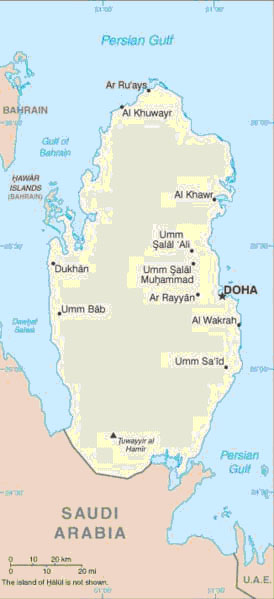 Il Qatar è uno dei vari emirati sorti nel XX secolo nella penisola arabica, che confina a sud con l'Arabia Saudita ed è per il resto circondato dal golfo Arabico.
Il Qatar è uno dei vari emirati sorti nel XX secolo nella penisola arabica, che confina a sud con l'Arabia Saudita ed è per il resto circondato dal golfo Arabico.
Dopo essere stato dominato per migliaia di anni dai persiani e, più recentemente, dal Bahrain, dagli ottomani e dai britannici, diventò indipendente il 3 settembre 1971.
Il Qatar, che durante gli anni Ottanta aveva sostenuto lo sforzo bellico dell'Iraq nella guerra Iran-Iraq, nel 1991 si oppose all'invasione irachena del Kuwait e si schierò al fianco delle forze che combatterono l'Iraq nella guerra del Golfo.
Le dispute territoriali con l'Arabia Saudita del settembre 1992 misero in crisi le buone relazioni tra i due paesi, che raggiunsero un accordo nel maggio 1993. Il 27 giugno 1995 l'erede al trono, Hamad bin Khalifa Al Thani, depose suo padre Khalifa ibn Hamad Al Thani, e avviò una politica di apertura verso l'Iran, l'Iraq e Israele, oltre a convocare le prime elezioni municipali nella storia del paese (marzo 1999 ) e a promulgare una nuova Costituzione (2003).
Il Paese ha una superficie di più di 11.000 km2 con una densità di popolazione pari a 51 abitanti/km2. Possiede inoltre circa 1.230 km di strade che hanno in programma di ampliare grazie alle entrate petrolifere, 4 aeroporti e tre porti principali: Doha, Halul Island, Umm Sa'id (Musay'id).
La ricchezza del Paese è il petrolio, che ne rappresenta la principale risorsa economica. I primi giacimenti furono scoperti negli anni Quaranta e la commercializzazione del greggio ebbe inizio dieci anni dopo. Nel 1974 il governo fondò la Qatar General Petroleum Corporation, ente deputato al controllo delle risorse petrolifere, precedentemente gestite da compagnie occidentali.
Il Qatar è membro dell'Organizzazione dei paesi esportatori di petrolio (OPEC – Organizzazione dei Paesi esportatori di Petrolio). Un'ulteriore risorsa è costituita inoltre dai giacimenti di gas naturale.
Paese con grandi risorse finanziarie e in fortissima espansione nei comparti industriale, edilizio, commerciale, turistico, rappresenta attualmente per le imprese italiane, il Paese più interessante nell’Area del Golfo.
 Si sta sviluppando in un momento in cui la concorrenza non è ancora così aggressiva e difficilmente affrontabile come negli altri Paesi del MEG.
Si sta sviluppando in un momento in cui la concorrenza non è ancora così aggressiva e difficilmente affrontabile come negli altri Paesi del MEG.
La dinamica visione strategica delle Autorità Qatarine, oltretutto, sta guidando e aiutando questo suo ritmo accelerato.
Il cartello dei 13 Paesi produttori di LNG (oro blu) ha scelto come propria sede Doha, capitale del QATAR, considerando che il Paese si appresta anche a diventare il primo produttore mondiale di questo oro, che per loro è adesso il secondo oro dopo il petrolio. Il Qatar è al terzo posto come riserve di Gas Naturale, con oltre 7.000 miliardi di mc di oro blu e possiede 3,7 miliardi di barili di Petrolio. Ha inoltre scoperto enormi giacimenti sottomarini e si appresta a diventare il primo produttore mondiale di LNG.
Il 70% dell’economia nazionale è costituito dalle “Oil & Gas Revenues” e il Paese importa tutto, in quanto non possiede proprie aziende manifatturiere e industrie rilevanti.
I settori in cui l’Italia è indiscussa maestra grazie alla propria cultura e al proprio gusto, cioè costruzioni, residenziale e arredamento, sono rinomati e ricercati dagli abitanti del Qatar. Ciò comporta la richiesta, ai nostri produttori, di macchinari e materiali da costruzione, arredamenti di vario tipo (fisso e mobili), accessoristica, oggettistica e quant’altro per residenziale, hotel , heath and care, parchi commerciali, senza dimenticare la fornitura dei relativi impianti di condizionamento aria, allarme, sicurezza, illuminazione, comunicazione, I.C.T etc. Lo stesso si può dire inoltre per l’impiantistica, di cui necessitano di “Oil & Gas, LNG , Petrolchimica, Energy , Trattamento Acque etc”, e per cui sviluppano importanti collaborazioni con i produttori italiani, risentendo infatti della carenza di tecnici specializzati nel settore.
Naturalmente non dobbiamo scordare che il Made in Italy, soprattutto per i settori moda e alimentare, in questo Paese si spinge oltre la crisi poiché ritenuto fattore distintivo.
Il Qatar vuole crescere rapidamente, ma lo fa nel rispetto dell’ambiente, procurandosi così i prodotti e i servizi per la depurazione, la dissalazione e la potabilizzazione delle acque e i prodotti e i servizi per la raccolta, lo smaltimento e il compostaggio dei rifiuti solidi urbani ed industriali.
THE PEARL
The Pearl è un investimento immobiliare di UDC Holding, una delle 100 Top Company del Medio Oriente. Il Senior Architectural Manager del progetto è Atos Batarra, Vice Presidente Business Council a Doha. The Pearl rappresenta uno scenario incantevole, variabile e seducente al solo sguardo.

Qatar Exibition Trade Center Made in Italy
Il progetto, che sorgerà a Doha, capitale del Qatar dove sono già in fase di realizzazione più di 100 grattaceli e si ha in programma di farne altri 400, si pone l’obiettivo di promuovere e vendere, in un Paese in forte espansione economica, i prodotti Made in Italy.
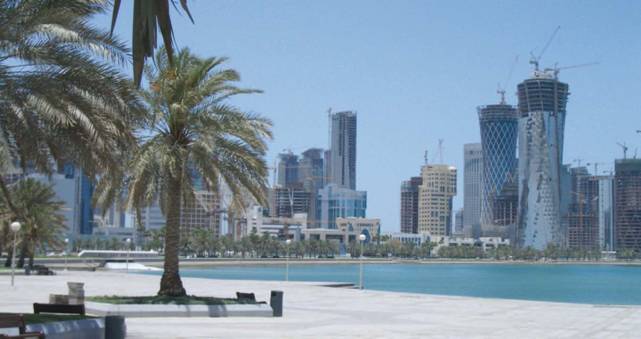
I settori di interesse sono costruzioni e arredamento, dai materiali specifici all’oggettistica.
Il Qatar Exbition Trade Center Made in Italy offre spazi espositivi autonomi per la presentazione del prodotto, affittati annualmente a costi decisamente inferiori a qualsiasi budget di spesa per penetrazione commerciale in Paesi terzi, permettendo alle aziende italiane di farsi avanti senza intermediari, svolgendo e pianificando tutti i servizi utili al disbrigo delle pratiche di vendita e di post vendita e coordinando pubblicità e marketing, formando sales manager, editando newsletter e report mensili.
 Il General Manager di ObiettivoQatar, Laura Bertuccioli, sostiene che il Qatar è un Paese che muta il proprio skyline con una rapidità incredibile e, a riprova del suo sviluppo, è un Paese che ha saputo mettere a frutto le proprie riserve petrolifere a partire dagli anni 60 e che oggi, attraverso tali rendite unite a quelle derivanti dalle forniture di gas, non è minimamente toccato da questa crisi mondiale.
Il General Manager di ObiettivoQatar, Laura Bertuccioli, sostiene che il Qatar è un Paese che muta il proprio skyline con una rapidità incredibile e, a riprova del suo sviluppo, è un Paese che ha saputo mettere a frutto le proprie riserve petrolifere a partire dagli anni 60 e che oggi, attraverso tali rendite unite a quelle derivanti dalle forniture di gas, non è minimamente toccato da questa crisi mondiale.
Il Qatar, continua il General Manager, pensa in grande e guarda con sempre maggior interesse alle aziende italiane non solo come fornitori ma come partners privilegiati e come territorio amico e per questo sta sempre più diventando una porta di accesso prioritaria per gli imprenditori e gli investitori interessati ai ricchi mercati del Golfo, e non solo del Golfo. Le holding private e pubbliche qatarine in joint con partner internazionali che hanno technicality & management stanno infatti investendo nel resto del mondo.
 Il Qatar ha grandi risorse economiche ed ambiziosi piani di sviluppo nel territorio e nell’intero Golfo.
Il Qatar ha grandi risorse economiche ed ambiziosi piani di sviluppo nel territorio e nell’intero Golfo.
Il tutto è però rallentato da due fattori endemici: la difficoltà a reperire le materie prime e tecnologia avanzata e la difficoltà ad avere disponibili le professionalità necessarie a gestire il continuo divenire.
Le holding e le aziende qatarine vogliono crescere in fretta sul territorio ed essere pronte subito ad intraprendere nel resto del mondo.
Vogliono velocizzare tempi e metodi e sono alla ricerca di partners (technicality & management) coi quali condividere i grandiosi progetti che non sono in grado di gestire da soli, come ad esempio “Le Torri”, così vengono chiamati qui i grattacieli, che sorgono e si sviluppano a velocità incredibile.
Con ObiettivoQatar, grazie ai consolidati rapporti con le Istituzioni di questo Paese ed a una importante selezione dei partner qatarini indispensabili per una propria presenza commerciale e produttiva in Qatar e, non solo, per attività in Qatar sono in grado di dare valida assistenza e supporto alle aziende italiane interessate al Qatar, a cominciare dalla pre-qualificazione presso le holding pubbliche e private, elemento fondamentale per intraprendere in questo Paese e/o da questo Paese.
Il Qatar Trade Center Made in Italy, continua la Bertuccioli, da un lato è un nuovo autonomo concept di vendita per le aziende italiane nella nicchia del costruire, dell’abitare e dell’ arredare che permette loro di presentarsi direttamente e di concludere affari nel cuore del mercato arabo dove l’edilizia sta correndo il proprio grand premio senza bisogno di pit stop. Dall’altro è il loro modo pratico e pragmatico di informare, comunicare e far conoscere velocemente questo incredibile Paese per aiutare le aziende italiane a crescere, ad essere sempre più internazionali specie in un momento di crisi come quello attuale.

Allo scopo di incentivare investimenti esteri nei settori dell' industria, tecnologia avanzata, turismo, agricoltura, e altri, da parte delle Autorità del Qatar, è attualmente in fase di realizzo la creazione di una Free Investment Zone (F.I.Z.). E' prevista in favore delle Aziende costituite all' interno della F.I.Z. una esenzione fiscale dall' imposta sui redditi (Income Tax), come pure da altre imposte, per un periodo di 20 anni (rinnovabile allo scadere).
Le Aziende saranno esentate dalle imposte doganali (Custom Duties) sulle importazioni di macchinari, impianti, prodotti, ecc. e sulle esportazioni di prodotti finiti e le stesse Aziende saranno autorizzate a trasferire i propri utili all' estero, senza limitazioni. Le stesse Aziende potranno accedere agli incentivi di ordine finanziario e creditizio previsti per gli investitori esteri nel Paese.
Il Governo Qatarino ha predisposto (“Q.D.B. – Qatar “Development Bank”) una serie di incentivi per gli investitori stranieri che intendono installare una attività manifatturiera come pure assistenza alla elaborazione di studi di fattibilita’o ricerca di Partners locali o percorsi di facilitazione per l’ ottenimento di licenze e permessi fino alla concessione di prestiti agevolati per la esecuzione del progetto
ORO BLU
Ci sono in progetto 12 rigassificatori, di cui il primo, un gigante d’acciaio da 290 mila tonnellate di peso, lungo 180 metri, largo 88 e alto 47, e soprattutto capace di lavorare fino a 8 miliardi di metri cubi di gas all’anno, sorge a 17 chilometri al largo del Delta del Po.
Due anni di lavoro per costruirlo, grandi difficoltà per trovare un bacino capace di accoglierlo nel giusto modo tant’è che si è dovuti andare fin sotto la rocca di Gibilterra, nella Baia di Algeciras.
Nello specifico, il gas estratto dai giacimenti nel Golfo Persico viene congelato a -136 gradi e in questo modo il volume ridotto fino a 600 volte.
Viene poi stivato nelle navi e trasportato al rigassificatore, qui utilizzando l’acqua di mare e la differenza di temperatura viene riportato allo stato gassoso. Un sistema di per sé più costoso dei gasdotti ma divenuto conveniente con il recente aumento dei prezzi degli idrocarburi.

1Fonte: Mondolibero
Il Settore Del Benessere In Italia
Recenti indagini di mercato hanno confermato come l’evoluzione del mercato del benessere sia riuscito ad adattarsi alle nuove esigenze di consumo. Aumentano infatti gli italiani che “investono” una parte consistente del proprio reddito e del proprio tempo nella cura del corpo e nella ricerca di relax e di svago. Secondo il Censis il 23% della popolazione frequenta regolarmente un centro fitness (palestra ormai è un termine riduttivo) e l’8,7% le strutture per la cura del corpo, mentre quasi 11 milioni di italiani spendono o si dichiarano pronti a spendere fino a 1.200 euro all’anno per prodotti e servizi volti ad acquisire una soddisfacente forma psico-fisica (Fonte Bain&company). Benessere, bellezza, equilibrio psico-fisico, relax, armonia mente e corpo, sono oggi le parole che caratterizzano e delineano un nuovo stile di vita e che creano per le aziende nuove aree di business. La ricerca del “benessere” determina nuovi valori e comportamenti d’acquisto per un sempre più numeroso target di consumatori.
Appositi studi condotti dalla Confartigianato ci segnalano che i centri Benessere detengono i record di natalità imprenditoriale con un tasso di crescita del 69,3% dal 2002 al 2006. In una società che sempre più investe nel Benessere della persona, si vanno delineando nuove forme di lavoro, nuove professioni e nuove opportunità lavorative, attraverso la nascita di Centri termali, Palestre e più in generale centri per il Benessere psico-fisico.

La domanda di Cure termali, beauty farm, palestre, fitness, appare oggi in grande espansione e lascia intravedere per i prossimi anni una crescita senza precedenti. Dal 1959 al 2003 gli italiani che praticano attivita sportiva sono passati da 1 milione e 300 mila (il 2,6% della popolazione di cui il 90,8% uomini) a 32 milioni e 24 mila (dati Istat-Coni). Un vero esercito che popola gli impianti sportivi privati gestiti da quasi 15 mila aziende che impiegano oltre 30 mila addetti. Uno studio di Unioncamere ha messo in evidenza che dal 2003 al 2005 il numero degli impianti sportivi in Italia è cresciuto in maniera esponenziale: in soli due anni si è registrata una crescita del 25,4%. Il boom delle palestre è testimoniato dal fatto che il numero di chi pratica attività sportive è cresciuto del 28% dal 1997 al 2004. Il business delle terme e dei centri benessere cresce a ritmi del 15% all’anno, superando ormai la fatidica soglia dei 10 miliardi di euro di fatturato annuo, con un’offerta estremamente variegata
L’economia del fitness e del wellness in Italia
Alla crescente attenzione prestata dagli italiani al benessere corporeo sono corrisposti rilevanti investimenti individuali (in denaro e tempo) in attività ad esso specificatamente rivolte.

Il mercato del fitness e del wellness si presenta peraltro fortemente articolato
La spesa oggi più consistente è quella riguardante le cure estetiche, legate prevalentemente a centri specializzati (oltre 11.000 in Italia), la spinta motivazionale risulta sempre più legata alla ricerca di identità che provochi soddisfazione, autogratificazione, piacere per sé. Da un’indagine condotta dalla Nielsen nel 1997 risulta, infatti, che le classi di età coinvolte in attività sportive nelle palestre sono distribuite abbastanza equamente, con una leggera prevalenza della fascia compresa tra i 25 ed i 34 anni (19,6% dei praticanti), ma anche con una significativa presenza di persone con più di 54 anni (16,1% dei praticanti totali). Al fianco degli appassionati di body building (circa il 14% del totale dei frequentatori di palestre) e degli stakanovisti della prestazione, si rileva un incremento delle persone che inseguono la possibilità di mantenere la propria forma fisica riducendo al minimo la fatica. In questo senso è da considerare l’evoluzione più recente dell’attrezzistica del fitness (fino agli elettrostimolatori presenti in più del 25% dei centri estetici), che promette la conquista della forma fisica eliminando la fatica.
Gli stessi motivi sopra indicati hanno consentito la rapida diffusione dei centri benessere (o beauty farm, almeno 33.000 turisti vi hanno soggiornato nel 2000) dove è possibile trascorrere periodi di riposo più o meno lunghi per dedicarsi alla cura del corpo come forma di piacere. La domanda di termalismo e beauty farm appare oggi in grande espansione e lascia intravedere, per i prossimi anni, una crescita senza precedenti. E’ sufficiente guardare all’ammontare complessivo delle spese effettuate nei comparti delle terme, dell’agriturismo e dei centri benessere privati per comprendere il potenziale di sviluppo di questo segmento di mercato.
La proliferazione di centri per le cure estetiche ha portato, inoltre, ad un livello di occupazione più che apprezzabile, con oltre 19.000 addetti, così come un elevato dinamismo caratterizza attualmente il settore termale con 15.000 addetti diretti oltre a 70.000 addetti generati dal relativo indotto (personale operante nel settore alberghiero e della ristorazione, nel comparto delle beauty farm e dell’estetica e del leisure).
Si è di fronte al tipico caso in cui la domanda di servizi sempre più sofisticati e diversificati ha determinato l’evoluzione e la trasformazione di un settore, quello del benessere, per il quale non si può che prevedere un’ulteriore espansione negli anni a venire.
Il Target dei “consumatori” del benessere
Un’indagine condotta dall’Istituto di ricerca NETS di Bologna ha identificato i comportamenti di quella fetta di popolazione italiana che presta attenzione alla forma psico–fisica e al benessere in genere, frequentando cure termali, beauty farm, palestre e centri benessere: 8 milioni di italiani, di cui 53% donne, 47% uomini, esaminati all’interno della popolazione adulta 18-65 anni. In particolare sono 5 milioni gli italiani che frequentano una palestra (56% abitualmente; 44% saltuariamente). Mentre sono 4 milioni gli italiani che frequentano, abitualmente o occasionalmente, un centro benessere. Tra i due gruppi vi è una sovrapposizione di 1 milione circa di soggetti. I frequentatori di palestre e di centri benessere vivono per il 56% al nord, per il 25% al centro e per il 19% al sud del nostro Paese. Emergono Lombardia (19%), Veneto (11%), Emilia Romagna e Lazio (entrambi al 10%), Toscana (8%); spiccano al sud Campania (6%), Puglia e Sicilia (entrambi al 4%). La segmentazione per fascia di età vede un 32% in quella 18-25, un 27% nella fascia 26-35 anni, 21% nella fascia 36-45 anni, 14% nella fascia 46-55 anni, 6% nella rimanente fascia 56-65 anni. Il 41% dei frequentatori di palestre e centri benessere è single, sposati/conviventi il 54%, divorziati/separati il 5%.
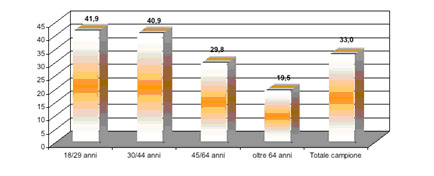
Guardando al “cliente tipo” delle terme e dei centri benessere, risulta subito evidente la trasversalità: l’interesse coinvolge tutte le fasce di età e reddito. Le spinte verso una vacanza di benessere sono diversificate in base all’età ed alla professione: per i giovani tra i 18 ed i 29 anni e per quelli tra i 30 ed i 44 anni i modi più diffusi per mantenersi in forma sono lo sport, le vacanze ed i viaggi brevi frazionati nel corso dell’anno, oltre al ricorso ai massaggi, alle tecniche di relax ed alle formule di “remise en forme” presso spa e beauty farm. Ben il 18,8% dei giovani tra i 18 ed i 29 anni frequenta centri per le cure estetiche, inclusi i centri benessere, così come accade per il 9,3% delle persone tra i 30 ed i 44 anni.
Concorrenza intersettoriale tra beauty farm, terme e centri benessere
L’industria del benessere in Italia è caratterizzata da importanti trasformazioni. Negli ultimi anni il mercato del benessere italiano è stato interessato da un notevole sviluppo sia in termini quantitativi sia in termini qualitativi: si sono affermati nuovi modelli di consumo. Questi nuovi modelli di consumo nascono all’interno di un mercato che riscontra una crescente domanda di servizi “integrati” , non solo servizi termali ma anche fitness , beauty e relax. Esistono sostanziali differenze tra il consumatore Wellness e il consumatore Beauty, ecco perché, nonostante queste piccole divergenze, sta nascendo la figura di un nuovo “consumatore di benessere” che è il frutto dell’integrazione fra queste due componenti della domanda: non una semplice somma delle caratteristiche delle due tipologie, ma piuttosto un’evoluzione della domanda. A un evoluzione della domanda deve seguire un evoluzione dell’offerta: l’industria del benessere deve rispondere con un offerta integrata. L’effetto congiunto dell’aumento della complessità nel rapporto domanda-offerta si riassume nella formazione di grappoli di bisogni interconnessi, ovvero nella tendenza della clientela a rivolgersi ad un unico fornitore per la soddisfazione di un insieme integrato di esigenze.
Principali risultati dello studio
Il settore è in crescita grazie soprattutto all’aumento del numero di iscritti. L’estrema frammentazione dell’offerta penalizza il business sotto il profilo della redditività; l’Italia è in netto ritardo, rispetto agli altri paesi europei, sulla realizzazione di “fitness network” (diretti e/o in franchising).
La crescita sarà originata soprattutto da un aumento del numero di iscrizioni ai fitness club e dal potenziamento dei servizi offerti non inclusi in abbonamento, mentre il costo medio degli abbonamenti tenderà ad una riduzione. Nel 2006 il valore del giro d’affari dei centri fitness era pari a 2 md. di euro; rispetto al 2005 si registra un incremento dell’1,9%. Lo scenario competitivo è caratterizzato dalla estrema polverizzazione dell’offerta: la presenza di piccoli operatori che dispongono di un singolo centro, è dominante. Negli anni più recenti, l’evoluzione dell’offerta favorisce i competitor internazionali, mentre per quanto riguarda gli operatori nazionali i segnali sono contraddittori: ad un’espansione del numero dei club per alcuni, si assiste ad un ridimensionamento di altri. I fattori critici per il successo nel business risiedono soprattutto nel progressivo slittamento da un’offerta meramente quantitativa (ampia disponibilità di attrezzi e servizi) ad una qualitativa, che consiste nel guidare il cliente all’interno della struttura garantendogli una adeguata programmazione delle attività, secondo le sue specifiche esigenze.
Dati mercato greco (2006)
Dati ed informazioni sugli sviluppi del mercato greco
Greece - Foreword
Greece is the cradle of western civilisation. Democracy, philosophy, art, poetry and science all have their origins in the country.Inspired by the past and empowered by the success of the OlympicGames, modern Greece is building a new image in the business world.The advantages of modern infrastructure, transport,communication andenergy facilities since the Olympics have created the right conditions forplacing the country at the centre of growing investment interest. The Games marked a milestone in the transformation of modernGreece. The first proper shopping centres have been developed andinvestment product of international standards has been increasinglyoffered to the market.
Greece, although a small country with 11 million inhabitants, is strategicallylocated between the important & fast developing geopoliticalmarkets of South Eastern Europe, a region with a population of over 160 million. Recent years have shown an increasing trend of institutional investorsseeking new horizons beyond their rapidly maturing home markets marking a new era for Greece.Cushman & Wakefield Greece, equipped with the most talentedprofessionals, is committed with great enthusiasm to supporting the market’s development, delivering professional real estate services tointernational standards, combined with the local experience.
Nicky Simbouras
Managing Director
Country Overview Greece is ideally placed geographically to form a gateway between Europe, the Middle East and Turkey, acting as a springboard into thiswider region.As Greece's neighbouring countries develop, the alreadyestablished business infrastructure will benefit further from this increasingly important consumer base.With Greece the only countryin the region which is part of the Eurozone, this will further aidGreece's positioning in the region.
The estimated consumer population of the Balkans and the Black Sea area is 320 million, with a GDP of USD 2,296 billion.The closer Balkanmarket consists of approximately 60 million consumers, of which 48million people live outside Greece's borders yet within 300 km of Thessaloniki, including countries such as Albania, Kosovo, the FormerYugoslav Republic of Macedonia (FYROM), Bulgaria, Romania, Serbiaand Montenegro.
The business environment in Greece has changed substantially over the last 10 years with privatisation and liberalisation of key industriessuch as energy, transport, and telecommunications helping to movethe country toward a thorough free market economy. This has aided investment in the telecommunications, manufacturing, energy, banking,services, trade, transportation and tourism sectors.The bulk of investments,in particular infrastructure projects, have taken place in the past five to six years (1999-2004), as political stability in the regionimproved and growth turned positive across South-East Europe.A vast under-provision of modern property has placed Greece on the
radar of both property developers and investors. Occupier demand is increasing steadily for modern space across all the commercial propertysectors, of which there is a general lack across the country.Themarket is expected to show good growth over the next few years, aided by the continued improvement of infrastructure projects thatare beginning to pay dividends subsequent to the huge investmentmade for the 2004 Olympic Games.
With a growing population, the residential market is expected to see impressive growth underpinned by increasing levels of available capital.Growth in demand in tourist-related coastal areas has been evenstronger meanwhile, with foreign interest concentrated in resorts along the Mediterranean and Aegean coastlines. A growing tourismmarket and relaxed investment regulations have encouraged somethingof a building boom in these areas, not only in residential developments but also in the hotel and leisure sectors as well.
Geography & People
Greece lies at the south-eastern tip of Europe covering approximately 132,000 sq.km. Its land border totals 1,228 km, with Bulgaria, Albaniaand The Former Yugoslav Republic of Macedonia (FYROM) to thenorth and Turkey to the east. Greece has 13,676 km coast line, with the Aegean Sea to the east of the mainland and the Ionian Sea to the west, with vast numbers of islands scattered throughout both.98% of the population are ethnic Greeks.The remaining 2% compriseof Turks, Pomaks, Jews,Armenians and various Roma groups.The only official language is Greek which is spoken by 99% of the populationwith English also widely spoken.The prominent religion is Greek Orthodoxy with 95-98% of Greekcitizens belonging to the Greek Orthodox Church. Muslims account for 1.3% of the population, mainly concentrated in the northernregion of Thrace. Roman Catholics, Protestants and Jews account forthe remainder. Mount Athos is recognised by the Greek constitution as an Autonomous Monastic Region and spiritually, Mount Athos isunder the Patriarchate of Constantinople.Greece is divided into 13 regions with 19% of the country's area accounted for by 3,000 islands. The climate is a temperateMediterranean one, with mild and rainy winters and hot, dry summers.Differences do exist across the country due to the country's topography, with 80% of the mainland accounted for by mountain chainsalong the central part of the country, with Mount Olympus the highestpoint at 2,917 m.The Attiki region and Eastern Greece are generally drier than the North and Western parts which see more rainfall.
History - Modern Greece
Greece was ruled by the Ottomans until 1821 when independence was first declared although not recognised until 1827 when the Ottomans were defeated at the battle of Navarino after a long anddrawn out struggle. In 1829 the Great Powers established one Kingdom of Greece which was finally recognised as an independentstate in 1830, with Ioannis Kapodistrias as President of the newRepublic.The republic was soon dissolved and a monarchy installed. Initially Greece's lands included the Peloponnese and the land masssouth of the Gulf of Volos. During the 19th and early 20th centuriesthis was extended, reaching its present configuration in 1947. Then followed turbulent times for the country. In 1917, during WWI,Greece sided with the Allies against the Axis Powers with the formernegotiating increased territory for Greece from the defeated Ottoman Empire whereby Greece was awarded Smyrna (modernIzmir).The Greco-Turkish War (1919-1922) followed and in 1922 theGreek army was defeated and Smyrna destroyed and large numbers of Asia Minor Greeks expelled from Turkey. In Greece itself there wasan army coup where high ranking officers were tried and executedand the King deposed.After ten years of republicanism, the monarchy was restored in 1935, but the King's acceptance in 1936 of a fascisttypedictatorship under General Metaxas, resulted in a damaging splitbetween monarchists and supporters of parliamentary democracy.
With the outbreak of WWII Greece suffered further. In 1940 the Italians, under Mussolini, demanded that Greece allow the Italiantroops to enter the country and surrender its arms. The Greekgovernment refused and a battle ensued with the Italians held back to Albania.The Germans then overran Greece in 1941 and forced theBritish to withdraw from the country. From 1942 conflict reigned withthe Germans until liberation in 1944. Civil war then broke out between the Communists and Monarchists which lasted until 1949when the former were defeated.In 1952 Greece joined NATO and the country enjoyed relative political stability and economic growth until the early 1960's. From 1965there was a period of governmental instability and intense politicalstrife which culminated in a military coup in 1967, forcing the King to leave and a military dictatorship was established. In 1974 the civiliangovernment was restored after the military junta fell as a result of itsunsuccessful coup in Cyprus against President Makarios, which aided the Turkish invasion of the island. In the same year a referendum votedagainst a return to constitutional monarchy and in 1975 a republicconstitution came into force. In 1981 Greece became a member of the then EEC and adopted the Euro in 2001.
Politics
Greece is a parliamentary democratic republic based on the 1975 Constitution. The prime minister and cabinet as well as the Vouli(parliament) play the central role in the political process.The presidentperforms some executive and legislative functions in addition to ceremonial duties.The last parliamentary elections held in March 2004 saw the centrerightNew Democracy party win a majority, with Costas Karamanlis president of the New Democracy party elected Prime Minister.The next parliamentary elections are due in March 2008.Whist there are a number of other political parties active, PASOK (Pan Hellenic Socialist Movement) is the dominant one.Political issues centre on relations with neighbouring Turkey, whichinclude hostility over historic events such as anti-Greek pogroms, territorial disputes in the Aegean and the as yet unresolved Cyprusissue, divided since 1974, with Turkey continuing to occupy 38% of thenorthern part of the island.
In 1996, tensions were high after a Turkish military invasion of the islets of Imia in the southeastern Aegean Sea. The crisis was diffusedafter intervention by the U.S. Relations have since improved after bothcountries suffered earthquakes in 1999 and offered each other help.Today Greece is a supporter of Turkey's struggle to join the EU.
Certain issues, however, remain at the forefront as Turkey still refuses to recognise the government of Cyprus and in May 2006 relationswere once again strained when a mid-air collision involving militaryplanes from both countries resurrected territorial disputes over sea and airspace. Recently public opinion has hardened somewhattowards Turkey's EU accession although support is likely to continue.Since the early 1990s, Greece has also been in dispute with the Former Yugoslav Republic of Macedonia, contesting the use ofthe name “Macedonia” by the neighbouring country as it implies aterritorial claim over Greece's own region of the same name.The UN is involved in continuing mediation efforts.
Economic Overview
Greece is a small but open economy, which has experienced considerable growth in the past few years, supported primarily by its entryinto the Eurozone. Moreover, it has experienced increased consumerspending and buoyant investment levels because of its hosting of the Olympic Games in 2004.The nominal GDP in 2005 equalled a relativelysmall $225.4 billion, however in GDP per capita terms the countryreached $20,530 per person in 2005, lower than the EU25 average of $29,351. During the late-1990's, the economy experienced a currencycrisis resulting in double-digit inflationary rates. However it recoveredowing to the government's policies of fiscal consolidation and financial reform and, more importantly, the strength of domestic demand.Consumer spending was underpinned by the increased availability ofcredit and the lower interest rates following the introduction of the Euro. Foreign Direct Investment levels have also been buoyant, with anumber of multinational companies investing in the country, particularlyin the telecommunication, information technology and retailing industries.With GDP growth having reached 3.7% during 2005 and similar levels ofeconomic activity forecast over the next two years, this will enable the country to reap more benefits from economic catch-up. Furthermorethe Greek government's strategy, which focuses on strengtheningpotential growth and employment, should also advance the country's economic convergence with the EU.Although the country continues toface challenges such as high public deficits and low labour productivity,its relatively greater macroeconomic stability, continued policy of privatisation and gradual structural reform, place the country in aposition to become an important focus of investor activity.
Regions
Greece's capital, Athens, is the leading centre for commercial and industrial activity and accounts for the greatest proportion of regionalGDP, around 38.1% in 2005, primarily supported by the public andprivate service sector. It has developed from an administrative and cultural centre to a primary economic and trade centre, chiefly due toits relatively strategic location and superior communication and transportationfacilities.The hosting of the Olympic Games has also had a considerable impact on the prosperity and development of Athens.The thirteen regions (NUT II) can be further segmented into threegroups.The first group is amongst the most prosperous, with relatively rapid levels of growth. It consists of Athens, Central Macedonia and theisland regions of Crete, contributing 38.1%, 17.4% and 6.9% respectivelyto Greece's GDP.The second group are primarily the poor, remote and stagnant regions, and include Epirus, Western Greece andPeloponnesus. The remaining regions are all growing at a moderatepace. With the exception of Athens, Greece has significantly less regional disparity than a number of its EU counterparts. However,improvements in transportation and infrastructure through the EU'sCommunity Support Framework, should promote economic decentralisation, particularly in the poorer regions.
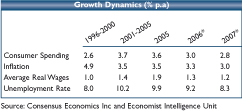 Current Trends The country has recorded robust growth over the past five years, particularly following its inclusion in European Monetary Union andthe hosting of the Olympic Games in 2004. GDP growth reached 3.7%in 2005, more than twice the growth rate of the Euro zone, boostedprimarily by buoyant growth in consumer spending and investment levels. Private consumption currently accounts for 66% of the country'sGDP and is expected to ease slightly over the outlook period. However, over the next five years, consumption growth is estimated to remain robust, driven mainly by favourable credit conditions and
Current Trends The country has recorded robust growth over the past five years, particularly following its inclusion in European Monetary Union andthe hosting of the Olympic Games in 2004. GDP growth reached 3.7%in 2005, more than twice the growth rate of the Euro zone, boostedprimarily by buoyant growth in consumer spending and investment levels. Private consumption currently accounts for 66% of the country'sGDP and is expected to ease slightly over the outlook period. However, over the next five years, consumption growth is estimated to remain robust, driven mainly by favourable credit conditions and
decelerated in 2005 as spending dropped off sharply in the wake of the Olympic Games, will see a revival in 2006 boosted by investmentincentives, privatisation programmes and the reduction of corporatetax rates. These two factors should continue to underpin economic activity, expected to average about 3.2% during the next five years.Unemployment levels are also expected to ease over the outlookperiod as labour reforms take effect.
Inflation, however, having been boosted by high energy prices and strong economic growth, remains above the Eurozone average,although an easing in price pressures is expected owing to therenewed appreciation of the Euro and moderating fuel prices in 2007.
The budget deficit remains stubbornly above the 3% minimum deficit target and is therefore a clear challenge for the government, despitehaving been reduced somewhat in 2005, suggesting a need for fiscaltightening going forward. National debt levels and the widening current account deficit are also major concerns going forward, bothhaving the potential to weaken the economy in the long-run.
Strengths & Weaknesses Of The Economy
Strengths
- Reform - The government is expected to continue to apply structural policies, albeit cautiously, over both the short and long-termacross several business and economic areas, boosting investment andeconomic stability. In general, these include tax, labour, privatisation and pension reforms. Tax reforms are coming into effect, albeit at alimited pace, that lower tax burdens for both households andcommercial enterprises, thereby stimulating investment. In addition, legislation has been passed that will enhance labour flexibility. In termsof pensions, the government is still facing pressure from the EuropeanCommission to launch a pay-as-you-go state pension system. Laws enforcing competition, the liberalisation of the public sector andPublic-Private partnerships have also been introduced and shouldenhance both economic growth and investment. Privatisation is becoming more widespread, with a number of programmes underway,such as the listing of the Postal Savings Bank on the Stock Exchange.
- Gradual Fiscal Adjustment - Policy is being implemented in order to secure long-term fiscal stability by establishing better and more efficientcontrols of public expenditure and reducing unnecessary publicspending.
- FDI potential - Greece experienced significant FDI growth in 2004, with levels doubling to equal 2.6% of gross fixed capital formation. Moreover, further potential for FDI growth exists whilst trade ties are expanding with the rest of the world.With new investment incentivelaws offering generous subsidies to private investment projects,combined with increasing macroeconomic stability and the government's willingness to push through necessary reform, considerableinvestment opportunities will exist over the next decade.
- Political environment - The current government is expected to remain in power until 2008, providing political stability and theexpectation of continued structural reform.
- Banking Sector - Recently buoyant economic activity has boosted profitability and capitalisation in the banking sector, making it a strongtarget for investment going forward. However, the potential rise ofhouse price inflation, and consequently an increase in the risk of default on personal debt, suggests an ongoing need for caution in the sector.
Weaknesses
- Debt and Deficits - Economic growth has been hampered by high levels of public debt (106.9% of GDP, 2005) and a large budget deficitwhich amounted to around -4.5% of GDP in 2005, above theMaastricht criteria's target of -3.0%.The rise in debt and deficit levels, more recently a result of public spending and infrastructureexpenditure for the Olympics, has created a need to implementconsiderable fiscal controls. In order to reduce these debt levels, the state needs to be acutely aware of its spending pressures, high debtservicingpayments and future pension costs.
- Inflation - The inflation rate has eased significantly in recent years although it may remain relatively high going forward, thereforepotentially restricting growth in the long-term and slowing the country'sconvergence with the EU-15 in terms of income per capita.
- Labour Force - The Greek labour market is still characterised by extremely high rates of unemployment, particularly amongst womanand young people and especially outside Athens and Thessaloniki.Policy initiatives have, however, been put into place in recent years in order to improve secondary education and to boost employment levels,which are forecast to increase in the medium term.
- Low Productivity - Economic growth is, to some extent, restrained by the country's limited human and capital resources. Much ofthe country's technology is somewhat outdated, whilst a significantproportion of the labour force is relatively unskilled. These problems are compounded by limited levels of business investment. Increasedproductivity growth is essential in order to enhance the level ofeconomic activity within the country.
INFRASTRUCTURE
Road
There is a good road network in all areas and national highways linking Athens with northern and southern Greece.In the run up to the 2004 Olympic Games, huge investments weremade in infrastructure projects.Two major projects were a ring road around Athens linking the international airport at Spata to the nationalhighway and the coast near Piraeus and a suspension bridge across themouth of the Gulf of Corinth, linking Rio and Antirio. Both projects have a positive impact on the property market with a number ofbusinesses relocating their accommodation in these more accessibleareas.
The new suspension bridge is linked at either end, currently poorly, but road upgrades include a package of six highway projects to bebuilt under PPP schemes. The projects include, among others, a newnorth-south motorway in the west of the country and new high speed links in the Peloponnese and the central plain. A number of other important infrastructure projects are underway; the Pathe highway, linking Patras via Athens to Thessaloniki and theEgnatia project stemming from Igoumenitsa in the north toThessaloniki and onto the Turkish border, the latter due for completion in late 2008.When finished, the motorway will reduce travelling timesacross northern Greece from the Adriatic to the Turkish border fromaround eleven hours to just six. Both projects were part funded by the EU.
Rail
Historically rail transport has been under funded as has The Hellenic Railways Organisation (OSE) and thus development of this mode hasbeen hampered. Rail links run from the south to the north, and thusthe south-eastern European hinterland is poor and under-used as a consequence. Improvements are being implemented to upgrade thenetwork, funded in the main by the EU's programme of trans-European networks (TENs). Whilst there are links from Thessaloniki in the north to the Balkan border, track conditions once across arepoor and make rail travel not the most efficient mode.The network in and around Athens is substantially better than the rest of the country as it received large investment in the run up to the2004 Olympic Games. The Athens metro was launched in 2000 andwhilst originally focused on the city centre, is now being extended into the suburbs.A major push for upgrading the system was the OlympicGames and a substantial amount of money has been spent on the system.Currently 4 lines operate, including a metrail extension to Athens International Airport. The significant extensions to the system willopen up the city further to the west and south, towards the futureMetropolitan Park (the old Hellinikon Airport site). The metro network, Suburban Railway not included, has a currentlength of 91 km and it is expected to reach 124 km (72 stations) bythe year 2009. Athens is also home to a 27 km tramway with an investment of Euro316 million that was completed ahead of the Olympics and links thecity centre with the southwestern suburb of Palaio Faliro, the southern suburb of Glyfada and towards the Piraeus district of Neo Faliro.Further extensions are planned towards the major commercial portof Piraeus and the southern suburb of Vouliagmeni.
The bus service consists of a huge network of lines operated by normal buses, electric buses, and natural gas run buses (the largest fleet ofnatural gas run buses in Europe).There are plenty of bus lines servingthe entire Athens Metropolitan Area.
Water
With 13,676 km of coastline and numerous islands Greece has a reported 123 cargo or passenger ports, 50 of which will be upgradedwith an investment of Euro 300 million.The main port location is at Piraeus which is one of the world's busiest ports and is located to the southwest of the mainland on theSaronikos Gulf.The commercial terminal has a throughput of 1.4 millionTEUs placing Piraeus among the top 10 ports in container traffic in Europe and the top container port in the East Mediterranean.Approximately 50% of the traffic is attributed to transhipmentcontainers. By 2007 the terminal will be connected by rail with the logistic centre in "Thriassio Pedio" and through this, with the Nationalrailway network, a fact which will upgrade it into an IntermodalTransportation hub. Thessaloniki is located on the northwest shore of the ThermaicosGulf and is the nearest European port for handling freight traffic toand from the Balkans, Eastern Europe and the Black Sea.
The Port of Patras is located in the north-west of the Peloponesse peninsula and is important in terms of linking Greece and Italy andNorth Africa. Whilst the port is used substantially for transportingpassengers, it also handles substantial amounts of cargo.
Volos is located at the head of the Gulf of Pagasitikos on the eastern Greek mainland. It is at the centre of Greece, allowing it to serve theentire country.The Port of Igoumenitsa is situated on the east side of the Corfu Channel, in Igoumenitsis Bay. It is considered the "Western" Gate ofGreece and facilitates maritime transport between Greece and Italy.It will be linked to the Egnatia highway, speeding up the movement of passengers and vehicles to Italy and the rest of Europe.

Air
The main, new international airport - Athens International Airport "Eleftherios Venizelos" (AIA) opened in 2001, replacing the old Athens(Ellinikon) International Airport. The new airport is located 33 kmsoutheast of Athens at Spata. It is accessible via Attiki Odos, a six lane motorway that makes up Athens City Ring Road.Athens and the Portof Piraeus are accessible via public transport by metro, railway andexpress airport buses. The airport was a Euro 2.2 billion investment and replaces the congested, centrally located previous airport. TheAIA project was a public-private partnership between the GreekGovernment and the private consortium led by Hochtief Aktiengesellschaft.The airport is ideally located to serve south east Europe, providingconnecting traffic from the eastern Mediterranean region, the Middle East, the Balkans, Africa and Greece to European and long hauldestinations. The current capacity is up to 16 million passengers and220,000 tons of cargo per annum, with potential expansion to raise passenger numbers to 50 million a year.In total, Greece has 39 international standard airports, many of whichhave been upgraded or rebuilt during recent years.The next five year plan includes expansion and renovation of 21 more airports, at a totalcost of more than Euro 400 million.
Telecommunications
Overall Greece has a modern telecommunications network that reaches all regions of the country. There are 6.4 million landlinesregistered and 3.8 million internet users. A staggering 97% of thepopulation own a mobile phone, served by the country's three largest mobile phone providers; Cosmote,Vodafone and TIM.The once state-owned Hellenic Telecommunications Organisation(OTE) was forced to reduce its monopoly in 2001, resulting in healthy competition in the sector. OTE now also operates in south-easternEurope and Middle Eastern markets as well.
Greece - A Market Summary
Real Estate
Over the last few years Greece has begun to move away from a market characterised by immaturity and one that was locally dominated, bothfrom an investor and occupier stand point.There is still some way to gobut the market is beginning to open up, offering a number of advantagesand is viewed to offer good potential. Additionally, as the neighbouringcountries to the north evolve, Greece is well placed for companies to locate in, serving these growing economies.The Greek market is small, with a limited number of large urban areas.However, the populations of Athens and Thessaloniki are relatively prosperous. Greece offers limited modern stock which satisfiesinternational occupier and investor requirements across all propertysectors. The market has been constrained by a tightly controlled development market, lengthy planning regulations and lack ofdevelopment expertise. However, the development market is startingto see increased levels of activity and a move away from the tightly overseen local market of the past. A number of multinationaldevelopers in both the commercial and residential sectors are nowactive typically in partnership or joint venture with a local firm. Investment procedures are changing with the establishment of theHellenic Centre for Investments (ELKE) to help streamline processesand they claim to have reduced the time to get investment approval to approximately three months, albeit with larger projects possiblytaking longer.There have, however, been reports that a further deterrentto foreign investment has been the influence of local businessmen using their contacts to delay or cancel projects, in particular withmodern developments in the leisure and tourism sectors.With further economic growth, the retail sector is faring the best and is receiving the greatest amount of foreign interest, especially in theshopping centre sector. Consumer tastes are evolving and acceptanceof new format retail is growing, supporting demand for modern space. However, traditional style high street retailing remains strong and isunlikely to diminish in the near future.There are opportunities in other sectors meanwhile, especially in the office and industrial sectors as public departments reorganise and theprocess of privatisation continues.With a strong and significant touristmarket meanwhile, coastal areas have seen a significant increase in interest in the leisure and hotel sector.This growth has also encouragedan increase in residential construction.
In the office sector the focus of activity is in and around Athens. The market is undersupplied and suffers from a severe lack of modernspace.With increasing demand for quality space from both nationaland international occupiers, the market should see some substantial developments in the near future.These are likely to be located alongnew and improved arterial routes where suitable development land isavailable and built properties accessible. Since Greece joined Europe's Economic and Monetary Union, theinvestment climate has changed quite considerably.The exchange raterisk is no longer an issue and this has opened up the market to a number of multinationals who are looking for opportunities to acquire propertiesthat on the whole are higher yielding that those in other partsof Western Europe. The development of the commercial property market will also be accelerated as the country's banking systemadvances. Until the last decade, the banking system was inefficient andconsequently Greece was less attractive than Spain or Portugal for example. Now however, current interest rates are low and securingcapital for investment purposes can be done with relative ease. IndeedGreece now has a relatively sophisticated banking sector, educated in understanding the difference between a viable development and onethat is unlikely to offer good returns.
Market Outlook
The outlook for the Greek property market is expected to be one of growth, although the pace is likely to be steady rather than dramatic.The market is still characterised by underdevelopment and limitedforeign investment, but the country offers considerable scope for growth simply as a function of the lack of modern supply which exists across all property sectors.Additionally whilst GDP and employmentgrowth are expected to slow over the next five years, it is still strongcompared to the European average. Business and financial servicessectors will drive output and new employment in the service sector is predicted to average around 9,000 new employees per year overthe next five years.There is increased emphasis on putting measures in place to make the market more transparent and deal with issues of bureaucracy andlengthy planning processes.Additionally the modernisation of existinglease structures to rebalance the current bias towards occupiers should be a focus.Traditionally the Greek market has received limited foreign interest asit has been dominated by national property companies and private, domestic investors. There has already been a significant change insentiment towards the market from international investors and occupiers with more investment and corporate activity.The market is becomingmore liquid and transparent and increased levels of both institutional and foreign investment is slowly emerging.With investment opportunities in Central Europe increasingly difficult tocome by and spending power in the Balkan countries still weak, Greece is an attractive alternative. Indirect investment is increasingly attractive andthis is likely to continue with the introduction of new REITs in the market.The focus will remain around the two major conurbations of Athens and Thessaloniki, although smaller regional cities may offer small scaleopportunities. Retail is the sector with the most growth potential andis likely to continue to be supported by a lack of modern retail space and good demand.There is space in the market for malls and leisurecomplexes, to attract multinational retail chains.In the office sector refurbishment is the key as planning regulation, especially in the city centre, is tight and there is a lack of suitable landplots. Peripheral areas will continue to grow and draw demand awayfrom congested city centres that additionally suffer from lack of adequate parking spaces. Occupier activity over the next twenty-fourmonths is likely to remain stable due to the continued consolidationand decentralisation of public departments. The vacancy rate will remain relatively stable as demand for space is likely to be counterbalancedby new development completions.With a lack of top specification industrial space, especially in the logistics sub sector, supported by an expanding retail market, rental levelsare expected to see some uplift over the next 1-2 years for top endprojects. Growth should also diversify away from being tightly located around Athens and Thessaloniki and activity will refocus along the newinfrastructure developments such as Attiki Odos.The leisure market should not be over looked and with a strong tourist industry there are opportunities for innovative schemes.There is a shift away from the typical hotel resort to integratedschemes including golf courses, spas and conference centres.
Investment activity in the sector is also supported by favourable tax incentives and government subsidies.A major new piece of legislation introduced in January 2006 is likelyto have an impact on the overall property market. VAT at 19% has been introduced on all properties with construction permits afterthat date to replace transfer tax for new properties. Compared to theold transfer tax of 11% this has made new construction effectively more expensive.The actual impact on the market has not yet been feltbut is not expected to be major, although demand for smaller sizednew-build properties and larger older properties is likely to increase.
Pre-let agreements are also likely to increase.
The Greek Property Market
OVERVIEW
Athens is very much the business and financial hub of Greece and as such, has the most active property market. Compared to Western andsome emerging Eastern European markets, Greece is relatively underdevelopedand immature, presenting numerous opportunities to thosewilling to invest. However, investors need to focus on medium termgains and must choose the right project and stay committed to it.The market is beginning to open up with the first quoted investmentcompanies, REICs now listed on the Athens stock exchange.
The government is also introducing legislation to stimulate investment in tourism and logistics as well as incentives for business investment.Both the main cities of Athens and Thessaloniki are home to relativelyprosperous populations who have an increasing appetite for newproperty concepts and, along with the modernisation of existing structures in favour of landlords, the outlook is bright. Additionallysince the hype of the Olympics in 2004, the country is now taking ona much more business-like approach and institutional investors are encouragingly beginning to like what they see.However, Greece comes with a lack of a sophisticated propertyregister and official data can sometimes be thin on the ground.Thereis a limited amount of modern stock satisfying international occupier requirements and a lack of development expertise across all sectors.
Tourism is of particular significance to the market, occupying a dominant position in the Greek economy. Over the last three decades Greecehas established itself as a popular tourist destination servicing allranges of the market. This in turn is boosting interest from both
domestic and international developers in the residential market, especially for luxury houses and villas in coastal areas.
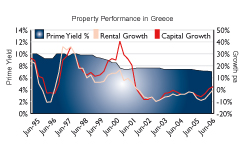 Investment
InvestmentSince 2000 the Greek property investment market has seen steady growth but real volumes of transactions are severely constrainedby the scarce amounts of suitable stock. Notable increases wereregistered in 2005 which saw approximately Euro 233 million invested in major deals across the property sector. Investor interest remainsstrong with Euro 190 million invested during the first six months ofthis year.
Geographically the main focus for the office sector has and remains centred around the capital city of Athens. Developer/investor interestfor the retail and industrial sectors are again focused on Athens butwith Thessaloniki as a secondary area of interest.
Owner occupation dominates the market making it very difficult to source stock, although this is beginning to change and with it anincreased amount of foreign and developer interest is emerging.Traditionally private and domestic institutions have been the main investors. Foreign buyers remain relatively cautious and Greeceremains an immature property market especially for cross-borderinvestors, some of whom have expressed concerns regarding tenant friendly leases and bureaucratic planning and development processes.However, the first six months of 2006 saw the largest transaction todate in the Greek commercial property market involving a foreign investor. Lamda Developments signed an agreement with HSBCProperty Investments for the latter to acquire 49.23% of The Mall inAthens for Euro 135 million, reported a yield of 6.10%.
Significant domestic investors meanwhile include The Greek Orthodox Church, which enjoys tax advantages that private investorsdo not. Foreign investors to date include Rockspring, Pradera, LaSalleInvestment, Credit Agricole, UKA APN as well as Klepierre and Sonae Sierra.Opportunity for investors will also increase as organisations in thepublic sector begin to sell their properties, either directly with vacant
possession or through sale and leasebacks. Yields in the office and industrial markets have remained relatively stablein recent years. Although the  office market is beginning to see primeyields move in, they remain more comparative to Central Eastern markets rather than the Western European core markets and in somecases are now higher than in Central Europe. The is in part due toa weak occupier market and very limited investment stock. Industrial yields have also begin to move in since the end of 2005, although they are not expected to fall dramatically in the short term. Retail yieldshave seen the most downward shift as the market becomes moreattractive to both occupiers and investors and new formats and international retailers show increased levels of interest.Prospects for the market are generally good with further yield compressionexpected as well as rental growth for top end schemes across all sectors.Regional cities may begin to pick up although any growth will bemarginal.
office market is beginning to see primeyields move in, they remain more comparative to Central Eastern markets rather than the Western European core markets and in somecases are now higher than in Central Europe. The is in part due toa weak occupier market and very limited investment stock. Industrial yields have also begin to move in since the end of 2005, although they are not expected to fall dramatically in the short term. Retail yieldshave seen the most downward shift as the market becomes moreattractive to both occupiers and investors and new formats and international retailers show increased levels of interest.Prospects for the market are generally good with further yield compressionexpected as well as rental growth for top end schemes across all sectors.Regional cities may begin to pick up although any growth will bemarginal.
THE RETAIL MARKET
Sector Background
Greece is enjoying an active retail scene, with increasing levels of international players entering the market, fuelled by the completion ofmore high quality retail schemes.
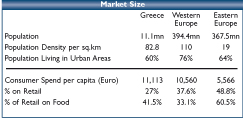
The increase in the overall provision of quality space has been a significant factor in drawing these international retailers in, to set upoperations in the Greek market.The expansion of the retail marketsin both Athens and Thessaloniki have been aided by infrastructure developments that have significantly opened up the market to locationswhere previously establishing a unit would have been unfeasable.Trading hours are between 09.00 to 15.00 on Monday,Wednesday and Saturday (some high street areas operate until 18.00 on Saturday) and09.00 to 14.00 and 17.00 to 20.30 on Tuesday,Thursday and Friday.Allshops are closed on Sundays. However these are not rigorously enforced. Supermarkets are allowed to open from 08.00 to 21.00Mondays to Saturday. General opening hours are soon to be extendedto 09.00 to 21.00.This new legislation is likely to increase competition among the larger retailers.
Occupier Trends
The Greek retail scene is quite fragmented, dominated by typically small shops in high street locations, owned and operated by individualcompanies. International retailers began to make an appearance in themarket in the mid 1990's led by the likes of the big hypermarket operators such as Carrefour. The majority of international retailersdo not yet have extensive networks of units and retail development ishighly concentrated on Athens and Thessaloniki, the two main cities of sizeable populations, and the domination of the high street will continueuntil more development of other formats come forward.
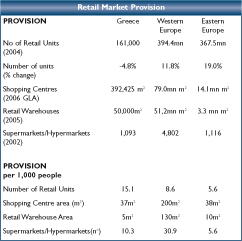 Since the late 1990s there has been growing interest from both national and international retailers, developers and investors, all lookingfor an opportunity to establish a foothold in the Greek retail scene.Their main focus has been in the shopping centre sector and schemes including leisure activities. Strict planning regulations and bureaucraticprocedures have hampered progress and few modern centres havebeen developed to date, small scale schemes dominating activity.
Since the late 1990s there has been growing interest from both national and international retailers, developers and investors, all lookingfor an opportunity to establish a foothold in the Greek retail scene.Their main focus has been in the shopping centre sector and schemes including leisure activities. Strict planning regulations and bureaucraticprocedures have hampered progress and few modern centres havebeen developed to date, small scale schemes dominating activity.
Shopping Centres
The Greek shopping centre market saw its first significant shopping centre openings in 2005: The Mall in Maroussi (Athens), City Link inAthens and Mediterranean Cosmos Centre in Thessaloniki.
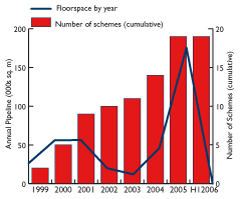 As a result of the current immaturity of the retail market, in-townlocations in Athens are still being exploited as shopping centrelocations, in addition to edge and out-of-town developments to servesuburban populations.The Olympic Games was viewed as a catalyst for retail developmentin the country, although several shopping centre schemes scheduled to be open in time for the Games were delayed, with developersfrustrated by often lengthy bureaucratic procedures.However, despite this slow emergence, the shopping centre market is expected to see a strong increase in development in the coming yearsto raise Greece's profile as an international destination for retailersand investors. Indeed while traditional high steet markets will remain competitive, potential for new development exists not only in Athensbut other regional cities as well. Greece has a total of approximately 392,000 sq.m which equates to 37 sq.m per 1,000 inhabitants - a figure closer to the EasternEuropean average of 38 sq.m and significantly lower than the WesternEuropean average of 200 sq.m per 1,000 inhabitants. There is just over 68,000 sq.m of space actually under constructionand a further 277,800 sq.m of proposed space in the pipeline until2009. On the assumption that all the space is brought to the market over the next 3 to 4 years, with consumer spending expected toremain relatively stable over the next twenty-four months, the marketis expected to be able to absorb the schemes will no pressure points of oversupply.
As a result of the current immaturity of the retail market, in-townlocations in Athens are still being exploited as shopping centrelocations, in addition to edge and out-of-town developments to servesuburban populations.The Olympic Games was viewed as a catalyst for retail developmentin the country, although several shopping centre schemes scheduled to be open in time for the Games were delayed, with developersfrustrated by often lengthy bureaucratic procedures.However, despite this slow emergence, the shopping centre market is expected to see a strong increase in development in the coming yearsto raise Greece's profile as an international destination for retailersand investors. Indeed while traditional high steet markets will remain competitive, potential for new development exists not only in Athensbut other regional cities as well. Greece has a total of approximately 392,000 sq.m which equates to 37 sq.m per 1,000 inhabitants - a figure closer to the EasternEuropean average of 38 sq.m and significantly lower than the WesternEuropean average of 200 sq.m per 1,000 inhabitants. There is just over 68,000 sq.m of space actually under constructionand a further 277,800 sq.m of proposed space in the pipeline until2009. On the assumption that all the space is brought to the market over the next 3 to 4 years, with consumer spending expected toremain relatively stable over the next twenty-four months, the marketis expected to be able to absorb the schemes will no pressure points of oversupply.
The City Centre Market
Traditional high street shopping is still very popular across Greece and will continue to compete with new format schemes such as shoppingcentres and retail warehouses for the foreseeable future.In Athens the most popular high street locations are the pedestrianised street of Ermou and the area surrounding Syntagnma Squareincluding Stadiou and Panepistimiou, Kolonaki Square and thesurrounding streets of Tsakalof, Skoufa and Patriarchou Ioakim. The northern suburb of Kifissia is also popular, with much of the pulldue to the affluent population who live there. Glyfada to the south isalso of equivalent importance. Voukourestiou Street, located in the city centre between Kolonaki andSyntagma square, is gaining importance as a high class retail pitch,where luxury brands such as Louis Vuitton,Todds, Cartier and Lancel are established. International retailer interest remains strong in Athens along the mainhigh street and there is sustained demand for prime units from a numberof large brands.With availability in these highly sought after locations limited, high premiums can be commanded.Thessaloniki, the second largest city and home to 1.2 million people,is the most significant retailing centre in the north of the country. Much of the retail here is still located within the city centre.The occupier market is performing well and whilst values havestabilized in the short term, the overall market has seen double digit growth in rental levels over the year-to-June. With quality unitsin short supply on the prime shopping streets, rental growth shouldcontinue, although the pace may slow.
Retail warehouses
There is little in the way of retail warehouse and factory outlet provision in the Greek market and therein lies potential opportunitiesfor real estate players who are willing to diversify into new formatretail that is likely to pay dividends in the longer term. Indeed, whilst from a low base there is now an increasing acceptance of new retailformats.There are only a handful of retail parks, although the ones in existence have proved to be quite popular with consumers. Typically they arelocated in more peripheral areas as land here is not only cheaper butmore available. The development of the sector will be aided by improved infrastructureprojects allowing ease of access.Indeed there are currently two parks in the pipeline both in the Greater Athens area. One is reportedly for IKEA who are looking toexpand their current operation located close to the new AthensInternational Airport at Spata and has enjoyed success. MacArthur Glen, meanwhile, will operate the first retail outlet in 2007 in theKantza area.
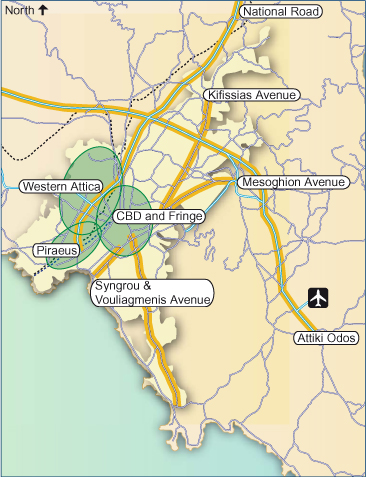 THE OFFICE MARKET
THE OFFICE MARKET
Sector Background
Athens is the dominant office market in Greece, followed by some way, by Thessaloniki. The majority of international companies onlyfocus their requirements on the Athens market.The much anticipated demand of the Olympics had less impact than expected on the property market overall.The most significant impactwas the investment made in infrastructure projects that have openedup some areas of the city.Whilst office availability was improved, with only about 20% of existing stock meeting international requirements,new space delivered for the Olympics has been absorbed, in the mainby the public sector.
As modern supply levels have falled back the office market is beginning to show some signs of stabilisation and could potentially see someupward rental growth in 2007 for selected areas. However, occupiersin the short term are likely to remain cost sensitive with growth focusing on better quality buildings with lower operating cost.
Occupational Demand
Over the last three years or so occupier activity has been relatively stable with between 120,000 and 150,000 sq.m of space transacted per year(although this includes owner occupier space which accounts of approximately50%). Accurate take-up levels however, are difficult to assess as there is a high proportion of off-market deals transacted directlybetween landlord and tenant. It is estimated that around 120,000 sq.mof space was taken off the market in 2004, with equivalent levels seen in 2005. With strong demand levels year-end totals for 2006 are expectedto see an increase on those recorded in 2004 & 2005.Underlying this level of activity is a drive for companies to consolidate their operations and look for cost effective solutions to their propertyneeds. Indeed, it should be noted that occupier activity should besustained for the next couple of years before levelling off as a major boost to the recent figures has been the reorganisation of the Greekgovernment relocating a number of ministries from the city centre tomore peripheral locations where cheaper, modern premises are available. At present both peripheral areas of the city and out-of-town locationsare popular. In these areas there is space to build modern developmentswith larger floor plates and adequate parking. The completion of transport infrastructure projects has aided levels of interest.There isOTE Building,Athens28
still demand for city centre locations with much of the focus being along Kifissias Avenue and the Attiki Odos area, stemming in the mainfrom multinational companies and some recent corporate merger andacquisition activity.  Rents are beginning to stabilise after three years of gradual decline and whilst further falls are not expected for centrally located space,levels may ease back in the more peripheral areas of the city andlocations such as Piraeus. However, out-of-town locations becoming more attractive and new developments coming online along the AttikiOdos for example, this is expected to attract more occupiers and anuplift in values should be seen. Thessaloniki is experiencing the same trend as the Athens market.Modern space in the city centre is almost non existent and the focusof interest is in peripheral areas of the city where there is increased parking and better access to the airport.There is limited demand forspace in the CBD and as occupiers are drawn away from the centre,availability levels have been increasing. The attraction of out-of-town areas has been aided by the Egnatia Odos project - a motorway linkingmajor locations across Northern Greece, making Thessaloniki moreaccessible overall.
Rents are beginning to stabilise after three years of gradual decline and whilst further falls are not expected for centrally located space,levels may ease back in the more peripheral areas of the city andlocations such as Piraeus. However, out-of-town locations becoming more attractive and new developments coming online along the AttikiOdos for example, this is expected to attract more occupiers and anuplift in values should be seen. Thessaloniki is experiencing the same trend as the Athens market.Modern space in the city centre is almost non existent and the focusof interest is in peripheral areas of the city where there is increased parking and better access to the airport.There is limited demand forspace in the CBD and as occupiers are drawn away from the centre,availability levels have been increasing. The attraction of out-of-town areas has been aided by the Egnatia Odos project - a motorway linkingmajor locations across Northern Greece, making Thessaloniki moreaccessible overall.
Supply
The overall vacancy rate is estimated to be between 8 - 9% and significantly lower at around 5% for modern stock. Much of the vacantstock is located in non-purpose built space offering small floor platesand space that is not cost effective to occupy. New developments are absorbed quickly as a result.There is an estimated 5 million sq.m of office stock across Athens,but only about 1.0 million sq.m can be classified as grade A and able to satisfy international occupier requirements. Refurbished spaceaccounts for approximately 1.5 million sq.m of the total stock andthere is a substantial amount of 'office' space located within residential buildings. The public sector also account for a large amount of officespace - occupying approximately 1 million sq.m.Historically the CBD was the most attractive area for businesses and received the most interest. Recently it has become less attractive due to high levels of traffic congestion, high levels of pollution, a severe lackof parking facilities and regulation restricting city centre access.Additionally occupier requirements have changed and with much ofthe CBD stock built in the 1950’s and 1960’s the typically small floor plates (under 500 sq.m) no longer satisfy these changing occupierdemands in the market. Supply levels in the CBD for top quality space are likely to remainlimited and the dynamics are unlikely to change in the near term asland shortages and planning regulations prevent increased development.
Any new developments are either pre-let or taken up very quickly. The area is still relatively popular with legal and financial companies,with the Athens Stock Exchange and various government ministriesstill located there. An additional point to note is that buildings in the city centre typicallyhave multiple owners which impacts on the maintenance and managementof the buildings. Elsewhere in Athens meanwhile, there are significant amounts of officespace located along the key roads of Kifissias Avenue and MesoghionAvenue, both thoroughfares between the CBD and the north and north eastern suburbs of Athens. With the Olympic Stadium andMedia Village close to Kifissias Avenue, the area received peak levels ofinterest in the run up to the Olympic Games. Mesoghion Avenue is the older of the two locations and has greater amounts of class B and Cspace and as such lower levels of demand. Limited constructionis expected in this area as there is very limited land available for development, although the refurbishment of older space may increase.Syngrou Avenue runs between the city centre and the southern suburbs.The area is home to a number of companies involved in the IT and pharmaceutical sectors as well as insurance and shipping companies.Recently the area has seen substantial redevelopment and refurbishmentof older buildings, making it more attractive, especially to those companies that require access to the city centre.With a limited number of sizeable developers in the Greek market,dramatic short-term changes in stock are unlikely. Additionally, international developers are trying to enter the market but both localand international companies are hampered by the lack of land in thecurrent office locations and any sites that may be available are expensive.
The Olympic facilities still to be assigned for new purposes are due to be leased, although this will not ease the undersupply in the officemarket as 90% of the space has been designated for retail use.Thessaloniki suffers severely from a congested city centre and supply, whilst evident, is not in great demand. Major infrastructure projectsincluding the creation of a 13 station metro and the City Hall projectcreating 870 parking spaces and office premises which should relieve some pressure, and attention may well begin to return to the centrein the longer term.
Development Trends
New transport infrastructure has fundamentally changed the office market in Athens. Peripheral and out-of-town office markets havebecome attractive locations providing occupiers with an opportunityto occupy modern offices, in accessible locations, at lower rents. Stock in Athens has been increasing gradually and the market is verylocally controlled, with the number of international developers limited.There are additional hurdles of a planning system that can be lengthy and bureaucratic.Developers continue to approach the market with an air of cautionand are reluctant to build on a purely speculative basis, preferring to secure pre-let agreements before commencing construction.However, due to the severe lack of international grade stock, morespeculative developments are being seen, although absorbed with relative ease. Since 2002 only around 380,000 sq.m has been added to themarket, with 2005 recording about 95,000 sq.m, much of which waspre-let. New schemes coming through are delivering much needed large floor plates meanwhile.New 'hubs' within the office market are beginning to emerge as investmentin infrastructure projects open up the Greater Athens region and begin to reshape the structure of the Greek office market. Significantnew areas of interest are those located along the Attiki Odos andsecondly the Athens Lamia National Road. Planning issues do not allow a large amount of sites in these areas to be developed. Majoroccupiers along the Attiki Odos include Ericsson, Schering Plough,Toyota and Bristol Myers Squibb whilst Siemens, Ernst & Young and Coca Cola have located along the National Highway.Vouliagmenis Avenue is making a comeback meanwhile and was oncea popular office location, supported in the main by the proximity to the old airport. Since its relocation, the area has lost some of its prestigebut with the redevelopment of the old airport site on the cards, thearea is likely to see growth over the longer term.The redevelopment into the Metropolitan Park scheme will cover 530 hectares andinclude leisure and residential space.
OFFICE MARKET DATA: A Summary
Stock
At the end of Q2 2006, whilst definitive figures do not exist, stock is estimated to be around 5 million sq.m across the Greater Athensregion, with 20% estimated to be grade A. The majority of stock islocated in the CBD submarket and along arterial routes running north to south, notably Kifissias Avenue to the north and Syngrou Avenue tothe south.
Availability
With a severe lack of quality space, availability at the top end of the market remains tight with overall vacancy rates hovering between8-9%.Availability is easing back as older stock is either refurbished tohigher standards and then occupied or removed from the market and redeveloped as residential space for example.
Development
The current amount of space under construction is between 100,000- 150,000 sq.m, with almost a third specifically designed for owneroccupation. New developments rarely reach the market without havingsecured at least one occupier.
Out-of-town and peripheral areas are the current focus of activity.
Take-up
Occupier activity ranges from between 120,000 - 150,000 sq.m per year, driven in the main by consolidation and companies exchangingspace in a pressurised rental market.The reorganisation of public ministries has also played an important role in recent years.
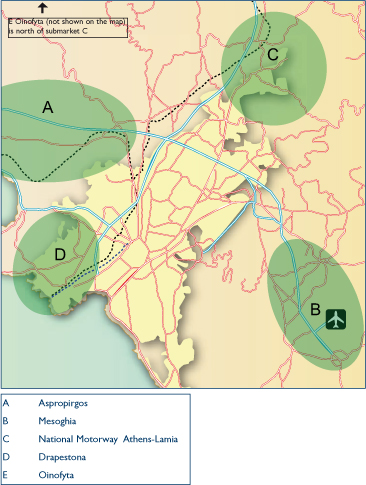 Sector Background
Sector Background
The industrial market in Greece is underdeveloped and owner occupation is very common. The logistics/distribution market in particular lagsbehind, although it is beginning to see increased levels of interest asmarket dynamics change and impact on supply and demand.There are two main focal points to the market: Athens in the southand Thessaloniki in the north.Athens is the major market, being boththe country's capital and economic centre, with almost 30% of thepopulation living there.The active Port of Piraeus is also nearby and isone of the largest container ports in Europe and thus a significantfocus for both national and international distribution. Thessaloniki isGreece's second largest city and seaport. Historically the port has been relatively isolated from the rest of the EU and not such anattractive location but, is now becoming increasingly important inserving the Balkan region.
Occupational Demand
Greece's industrial market is relatively immature and the quality ofstock lags behind the more mature markets of Western Europe.However, with occupier demand generally on the rise and new international requirements, there is increased pressure to deliver high quality, top specification space in well located, accessible areas. Additionally pressure is being exerted by an expanding retail sector which has an increasing need for distribution warehouses.Third party outsourcing is more popular as companies restructure and merger and acquisition activity continues, both supporting healthy levels of demand. Domestic players currently account for the lion's share of demand but this is gradually changing as the market opens up. Indeed more foreign operators are taking an interest in establishing operations in Greeceand are increasingly driving the development of the market. Key areas
of interest are close to major arterial roads such as Attiki Odos and the National Highway in Athens, allowing for the efficient transportationof goods around the country and to strategic ports without the needto negotiate the congested roads of Athens City.Prime rental levels are down approximately 15% from their peak in2001 - 2002 but have been stable over the last twelve months or so.Rents have fallen as the range of potential locations has been openedup by infrastructure developments and, additionally, governmental incentives drawing companies away from the city centre to moreperipheral areas, where development costs are lower. Sustaineddemand may well put pressure on rental levels, in 2007, particularly given a preference for leasing rather than owning. There are two dominant types of requirements in the market.The firstis for space between 3,000 - 5,000 sq.m suitable for those companieslooking to consolidate their operations into more efficient buildingsthat are cost effective. The second is for large scale schemes over15,000 sq.m that are suitable for retailers such as supermarkets.
Supply
Overall supply levels remain limited in a market that is characterised by owner occupation.Any existing availability is found mainly in small,older stock that does not meet international requirements. However,these do present redevelopment opportunities and any new space
delivered to the market is absorbed with relative ease as was the 280,000 sq.m released after the Olympics in 2004.Across the Greek market schemes continue typically to be constructedon a built-to-suit basis with limited speculative space in the development pipeline. However, the market dynamics are changing and as suchmore speculative space is being developed especially along the newarterial routes where demand for logistics and storage space is high and are areas that are receiving large investment at the moment.Construction is continuously being pushed to more peripheral areasas a result of planning regulations and land availability.
The majority of construction in and around Athens at the moment is to the west of the city in areas such as Elefsina, Aspropirgos andMandra which allow easy access to the north, west and south of thecountry. In the north locations such as Lalohori, Sindos and New Malgara to the west of Thessaloniki are popular as they give access tothe south as well as the bordering countries to the north of Greece,whilst drawing on the skill base resident in Thessaloniki. Supply may be eased slighty in Athens as reportedly the governmenthas put out a tender for 240,000 sq.m of logistics space to be developedin Thriasio, next to the Attiki Odos, in the western suburbs of Athens. This will additionally aid infrastructure developments and open up theareas to the west a little more.
Development Trends
Greece's industrial market remains immature and under developed, thereby presenting opportunities to developers and investors alike as occupier interest steadily increases.Additionally the country's exports to its neighbours, especially the Balkan countries, are expected to increase and thus add to the development of the market and the establishment of key hub markets within the country. The neighbouring economies will also improve in the run up to some entering the EU and this will create further demand from international companies for modern, high specification space. At the same time however competition may also increase from these Eastern European countries. For example Microsoft recently reported that it plans to open a logistics centre in Bulgaria from where it will serve clients from all Balkan countries, including Greece. The expansion of retailers and increased levels of outsourcing are expected to continue which will in turn drive demand and development activity for logistics platforms. New formats and robust consumer spending should generate strong demand growth among retail and distribution operators. Sophistication will further be aided by government subsidies which are offered for the development of large-scale distribution facilities, supporting investment in the sector and playing a significant role in establishing industrial hubs across the country. Government incentives in particular continue to encourage operators to locate outside the Greater Athens area in more decentralised areas. Indeed, whilst previously inaccessible, with investment in transport links such as the National Road and Athens Ring Road continue to act as a catalyst for the creation of modern warehousing facilities and the expansion of the sector. Moreover, as manufacturing improves, large purpose-built distribution and logistics facilities are beginning to emerge supporting the ports and the new international airport at Spata. Large scale investment in infrastructure projects will continue to open the market and spur the development of the overall Greek industrial market, funded in part by the EU. However, there are still large areas of the country that suffer from poor accessibility as the focus of the projects has been Athens and Thessaloniki. In certain areas land prices have also become expensive as the restrictive planning has meant that large sites suitable for a distribution hub trade at a premium. It has also been reported, rather ambitiously perhaps, by the Development Minister that twenty industrial zones will be created by the end of 2007.Two of the zones will be on the island of Crete. The Ministry will spend Euro 173 mn on the extension and upgrade of another 27 industrial zones in the country, with
substantial funding under the Operational Programme "Competitiveness" of the EU's Third Community Support Framework.
Prospettive di Sviluppo franchising tra Italia e Ucraina (2006)

Download the research: sviluppo_franchising_tra_italia_e_ucraina
To learn more: This email address is being protected from spambots. You need JavaScript enabled to view it.
Le novità della Legge Bersani per la panificazione in Italia (2007)

Download the research: mercato_pane
For information: This email address is being protected from spambots. You need JavaScript enabled to view it.
Il mercato cinese (2008)
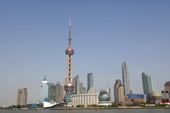
Crescono le opportunità sul mercato cinese per il made in Italy di lusso e non
Download the research:
Il mercato cinese
To learn more: This email address is being protected from spambots. You need JavaScript enabled to view it.
Italian Exports (2008)
"Currently the most relevant sectors for Italian exports are in manufacturing, fashion, gastronomy and technology"
 Fashion, luxury and foodstuffs…these are the leading sectors for the diffusion of Italian brands abroad, with expansion systems that are as agile and flexible as franchising. The historical survey of the study centre Luigi Einaudi and Sisim underlines that amongst the most global brands there are, Max Mara, which operates in 61 countries, 3rd behind the French Yves Rocher (in 68 countries) and Lacoste. The first business model for the internationalisation of franchising was implemented by the fashion brands: from simple stylists to multifunctional complex structures, able to integrate the in-house know-how, with the distributors’ and advertisers’ experience.
Fashion, luxury and foodstuffs…these are the leading sectors for the diffusion of Italian brands abroad, with expansion systems that are as agile and flexible as franchising. The historical survey of the study centre Luigi Einaudi and Sisim underlines that amongst the most global brands there are, Max Mara, which operates in 61 countries, 3rd behind the French Yves Rocher (in 68 countries) and Lacoste. The first business model for the internationalisation of franchising was implemented by the fashion brands: from simple stylists to multifunctional complex structures, able to integrate the in-house know-how, with the distributors’ and advertisers’ experience.
The best outcome achieved by the Italian brands has been to convert the notoriety of the trade names into models, banners and distributive formats recognisable worldwide. Globalisation has removed the gap existing amongst the national differences of the consumers addressed.
In fact, starting from the Western countries and spreading to East Asia, Eastern Europe and the Emerging economies, the generalised rise in purchasing power and the wider offer of branded goods at low prices, has allowed the vast majority of buyers to access the golden world of fashion brands.
Beside the above there are production and distribution firms that manage their own commercial network, exploiting an organisational and logistical know-how based on strategies completely different from the ones implemented by the large fashion enterprises like Coin, Benetton, Stefanel and Calzedonia/Intimissimi. The main penetration strength and the competitive lever have been represented by the knowledge of a specific market. Coin’s driving markets are Italy and Germany. Stefanel was gaining 74% of its turnover from its domestic market, but it is present in more than 22 countries, including Germany, Greece, Portugal and Taiwan. The survey mentioned above highlighted how from July 2000 to June 2001, investments by Italian brands had been mostly channelled in three foreign countries: Japan (with 67 new outlets), Germany (54) and the USA (42).
There are mature markets, such as the USA, where the product’s quality combined with tailored promotional activity, guarantees commercial niches for the enterprise, mainly in the textiles, technological and agro industrial sectors.
The “Mediterranean” market is, on the other hand, a territory requiring processes for an all-inclusive integration, non only on the economics stance, but also cultural, as by 2010, it will become a large free trade area, that cannot be assessed solely on commercial terms. In such areas, it is necessary to create the appropriate conditions for our SMEs, in order to be able to reduce production costs and also to transfer know-how to local firms, aiming at the implementation of co-development projects, for these entities to learn to walk on their own legs.
At present the most interesting sectors are the fashion, gastronomy and high-tech ones.
 "The restorative-gastronomy franchising sector is still in its infancy, however Italian labels and food products are becoming increasingly visible"
"The restorative-gastronomy franchising sector is still in its infancy, however Italian labels and food products are becoming increasingly visible".
For the franchising enterprises under scrutiny, highly vulnerable towards changes in consumers’ tastes, the protection of the distributive function has been successful, due to the acceleration of the textile/clothing cycle, the knowledge of the main market and the good outcome of the brand policy. For the fashion franchising enterprises it is necessary, to evaluate the “results” of their choices “on location” and in direct contact with the consumer, reducing to the minimum any image-related issues along the ideational-productive-distributive path.
The restorative-gastronomy franchising sector is still in its infancy, however Italian labels and food products are becoming increasingly visible. Through franchising and its respective commercial agreements, entering an international market brings competitive advantages in terms of Brands and company image and many benefits implying a market penetration at lower costs.
Franchising is different from other forms of agreements, given its capability to enter into force for the joint pursuit of a common mission, employing the knowledge and experience transferred by the franchisor enterprise:
» Securing pre and post sale services by complying with the local needs but, above all, attaining growth rates in shorter time spans and transferring part of the investment burden to their own partners;
» Attaining economies of scale;
» Creating entry barriers;
» Accessing IT resources;
» Overcoming entry barriers;
» Sharing the work and the risks, splitting the turnover amongst several markets with different characteristics and rhythms.
Internationalisation of small enterprises More than 90% of Italian exporters are small enterprises. The average size within this sector has gone down over time: from 10 to 9 employees between 1996 and 2003. Rather than a real streamlining within the enterprises, the result can be best interpreted as a clear sign of an improved accessibility to international markets and the entrance of new exporters. Analysis of exports by sector shows that SMEs’ influence is particularly marked in the services industry. Operators of limited dimensions determine large volumes of exports in wholesale trade, with a share greater than 80%. Microenterprises play a leading role, with 45% of Italian exports, compared to an average level of 10%.
 The share of small enterprises, on average 22.7%, is 40% greater in the wood, leather and shoe industries. Significant quotas, always above 30%, are recorded in the textiles, furniture, clothing, foodstuff and building products industries. In these sectors, SMEs shares have markedly shrunk over the past two years, probably due to a wider exposure to international competition of emerging countries. Amongst the other sectors, only the electrical and electronic equipment sectors have experienced a rise in their shares (almost 2%). As for exports, the most relevant sectors are wood and wood products, where the share of small enterprises (in terms of employees) is above 40%, and the textile, clothing, leather and shoe sectors with shares between 12 and 20%. The strong propensity to internationalisation, therefore, seems to confirm the endeavour of small enterprises in keeping competitiveness in their own sectors of specialisation.
The share of small enterprises, on average 22.7%, is 40% greater in the wood, leather and shoe industries. Significant quotas, always above 30%, are recorded in the textiles, furniture, clothing, foodstuff and building products industries. In these sectors, SMEs shares have markedly shrunk over the past two years, probably due to a wider exposure to international competition of emerging countries. Amongst the other sectors, only the electrical and electronic equipment sectors have experienced a rise in their shares (almost 2%). As for exports, the most relevant sectors are wood and wood products, where the share of small enterprises (in terms of employees) is above 40%, and the textile, clothing, leather and shoe sectors with shares between 12 and 20%. The strong propensity to internationalisation, therefore, seems to confirm the endeavour of small enterprises in keeping competitiveness in their own sectors of specialisation.
Official Figures from the Ministry for Foreign Affairs on the Internationalisation of the Italian System:
» Rapporto Ice
» Capitalia (2002), Indagine sulle imprese manifatturiere Ottavo rapporto sull’industria italiana e la politica industriale
» Unioncamere (2005), Le piccole e medie imprese nell’economia italiana Rapporto 2004
» Formez (2004), La governance dell’internazionalizzazione produttiva Quaderno n.27
» The Unioncamere-Mediobanca report on medium industrial enterprises has documented as the turmoil, in other words upward and regressive movements amongst the different types of enterprises, has been increasing over the past years and, in general, has mainly concerned growth processes.
» Rapporto Sisim- Enaudi
» Sole 24ore
» Italia Oggi
Written by Federico Fiorentini
General Manager
BRD Consulting Company, Italy
www.franexcel.com
To learn more: This email address is being protected from spambots. You need JavaScript enabled to view it.
Gli italiani e gli acquisti nel settore dell'abbigliamento e calzature (2008)
Abbigliamento: per quanto ancora al centro dei desideri degli italiani? L' importanza attribuita agli acquisti nel campo dell' abbigliamento e delle calzature
SINTESI DEI RISULTATI
La sensibilità verso la moda, il piacere dell’acquisto di un capo d’abbigliamento o di un bel paio di scarpe, sono aspetti della ‘cultura’, dello stile di vita italiano, difficili da scalfire. E ancora oggi, nonostante evidenti segnali di crisi della capacità di reddito delle famiglie italiane, sono 8 su 10 gli intervistati che considerano gli acquisti nel campo dell’abbigliamento una cosa a cui tengono molto.
 Quello dell’abbigliamento, dunque, almeno in termini di desiderata, appare un settore la cui domanda interna risulta difficilmente comprimibile. Tuttavia, il sondaggio rivela una serie di crescenti difficoltà da parte degli italiani ad appagare i propri desideri: sembra infatti che il gap tra ‘principio di piacere’ e ‘principio di realtà’, ovvero la distanza che separa il desiderio di rinnovare e ampliare il proprio guardaroba dalla sua concretizzazione in decisioni di acquisto, si stia ampliando.
Quello dell’abbigliamento, dunque, almeno in termini di desiderata, appare un settore la cui domanda interna risulta difficilmente comprimibile. Tuttavia, il sondaggio rivela una serie di crescenti difficoltà da parte degli italiani ad appagare i propri desideri: sembra infatti che il gap tra ‘principio di piacere’ e ‘principio di realtà’, ovvero la distanza che separa il desiderio di rinnovare e ampliare il proprio guardaroba dalla sua concretizzazione in decisioni di acquisto, si stia ampliando.
Basti pensare che oggi, ben il 40% degli italiani dichiara di comprare meno cose rispetto a qualche anno fa, una scelta che risulta fortemente correlata alla capacità di reddito degli intervistati, dato che la percentuale di coloro che comprano meno aumenta esponenzialmente al crescere delle difficoltà economiche incontrate. Inoltre, oltre un terzo degli intervistati (36%), nonostante l’aumento dei prezzi, oggi spende meno, confermando una chiara tendenza al risparmio che attraversa numerose famiglie italiane, soprattutto di quelle monoreddito.
Segmentando il campione per comportamenti d’acquisto e di spesa, tenendo cioè conto della relazione esistente tra aumento/diminuizione della quantità degli acquisti e aumento/diminuzione della spesa, la situazione appare la seguente:
- A fronte di un segmento – ancora corposo (37%) – di italiani che, potendo contare su una certa tranquillità economica, riescono ad investire ancora in maniera significativa nel campo dell’abbigliamento, troviamo una serie di situazioni meno brillanti, che evidenziano diversi gradi di difficoltà e differenti approcci risolutivi da parte delle famiglie.
- Innanzi tutto, esattamente agli antipodi rispetto al segmento dei più agiati, troviamo un cospicuo segmento di soggetti che sono già in regime di austerity: il 30% del campione dichiara infatti di aver ridotto sia il numero di acquisti che la spesa nel campo dell’abbigliamento, un target che evidenzia difficoltà economiche anche gravi.
- Accanto a questi, troviamo un ulteriore target di soggetti in difficoltà (9%), i quali hanno già operato dei tagli sui volumi d’acquisto ma che, ciò nonostante, continuano a spendere più di prima. Si tratta evidentemente di un segmento che sta subendo una significativa perdita di potere d’acquisto e che, probabilmente, fatica a rinunciare alle proprie abitudini e alla qualità.
- Ci sono poi quelli che (un ulteriore 8%), pur avvertendo difficoltà economiche, stanno reagendo alla perdita di potere d’acquisto ‘ingegnandosi’: sono quelli che, non volendo rinunciare alla quantità, abbassano le proprie pretese e riescono a risparmiare, spendendo quanto o addirittura meno di prima.
- Infine ci sono quelli che all’abbigliamento tengono meno (soprattutto i più anziani) e che, pur senza grandi capacità di reddito, hanno saputo trovare un punto d’equilibrio tra le proprie disponibilità economiche e i loro acquisti. Si tratta di un segmento rilevante (16%), moderato negli acquisti e tendente al risparmio.
La situazione, pertanto, non appare particolarmente rosea, poiché evidenzia per la maggior parte degli italiani una tendenza alla compressione dell’investimento nel campo dell’abbigliamento, dovuta principalmente a fattori di tipo economico. Non è un caso che oltre 6 italiani su 10 aspettano i saldi per effettuare i propri acquisti più importanti, sempre più non solo per i capi invernali ma anche per gli estivi.
Inoltre, tale tendenza è confermata anche dal fatto che l’abbigliamento sta via via scivolando al terzo posto all’interno della graduatoria degli acquisti degli italiani.
Per quanto riguarda gli stili di consumo, o meglio i fattori motivanti che più incidono sulle scelte d’acquisto, gli italiani appaiono molto decisi.
Innanzi tutto, tra quantità e qualità, 7 su 10 scelgono la seconda, preferendo ‘investire’ su capi che, grazie ad una migliore fattura, siano in grado di garantire una certa durata nel tempo. Si riduce quindi ad un quarto del campione la quota di coloro che, pur di cambiare e rinnovare spesso il guardaroba, sono disposti a scendere a compromessi sulla qualità (in prevalenza giovani). Inoltre, la qualità risulta vincente persino sulla moda e sul prezzo, fattore quest’ultimo, che di questi tempi raccoglie comunque un terzo delle citazioni.
Ci troviamo di fronte, pertanto, ad una maggioranza di consumatori estremamente sensibili al tema della qualità - per quanto con questo termine ognuno di noi possa intendere cose diverse – e ciò, in un clima economico poco favorevole come l’attuale, può facilmente ingenerare fenomeni di frustrazione in coloro che si vedono costretti al risparmio. La risposta del ‘low price’ infatti, per quanto sicuramente già sfruttata da un segmento ampio di cittadini, non appare coerente con il desiderio di acquisti di qualità da parte degli italiani.
Per questo motivo i saldi, oggi, rappresentano un’ancora di salvezza per quasi due terzi degli intervistati, che li attendono prima di effettuare gli acquisti più importanti.
Da questo punto di vista, però, il ruolo un tempo centrale dei negozi tradizionali del centro cittadino è sempre più messo in discussione. Sono numerosi ormai gli italiani che non hanno preferenze (quelli con più problemi finanziari addirittura li evitano) e si assottiglia la distanza con i negozi presenti nei centri commerciali.
I RISULTATI DELL' INDAGINE
Abiti e scarpe costituiscono ancora un catalizzatore d’interesse e di spesa per l’80% degli italiani, mentre solo 2 intervistati su 10 mostrano scarso interesse per gli acquisti nel campo dell’abbigliamento e delle calzature.
Il core target degli acquirenti, ovvero il segmento di quelli che al guardaroba tengono molto, è ancora abbastanza consistente, poiché rappresenta circa il 30% della popolazione adulta.
L’interesse verso gli acquisti nel campo dell’abbigliamento risulta maggiore tra le donne, tra i giovani (under 35), tra i residenti al Sud e nelle Isole (mentre si rivela sotto media tra quelli del Nord e soprattutto del Nord Est); cresce, inoltre, all’aumentare del livello d’istruzione conseguito. Lo status economico delle persone, invece, per quanto correlato all’interesse per questo genere d’acquisti (tende in effetti a diminuire al crescere delle difficoltà finanziarie), presenta con esso una correlazione assai debole. Su questo valgano due dati: persino tra quanti si sentono poveri o fanno molta fatica ad arrivare a fine mese l’interesse verso il guardaroba non scende mai al di sotto del 75%; i soggetti più sensibili a questo genere di acquisti sono quelli che cominciano ad avvertire qualche difficoltà economica.
Se ne deduce pertanto che, almeno in termini astratti di desiderata, la domanda di abbigliamento in Italia tende ad assumere i caratteri dell’ “anelasticità”, fattore che, complice la perdita di potere d’acquisto da parte dei consumatori, rischia di generare o amplificare sentimenti di frustrazione.
Se dal punto di vista ‘ideale’ l’abbigliamento si colloca ancora al centro dei desideri degli italiani, questo però non significa che le loro priorità, abitudini e comportamenti d’acquisto non stiano cambiando: il sondaggio ci consente di cogliere una serie di segnali in questa direzione.
Innanzi tutto, sebbene la maggioranza relativa del campione (43%) continui ad attribuire la stessa importanza di prima agli acquisti di abiti e scarpe e 2 italiani su 10 li considerino addirittura più importanti di qualche anno fa, l’indagine evidenzia che per oltre un terzo degli intervistati (36%) gli acquisti nel campo dell’abbigliamento sono diventati meno importanti. 
Una tendenza significativa e pericolosa perché, per quanto condizionata da fisiologiche dinamiche anagrafiche (cresce con l’avanzare dell’età ed è dunque maggiore tra gli anziani), appare fortemente correlata alla capacità di reddito delle famiglie. Non a caso tale percentuale cresce, fino a raggiungere il 50%, tra i soggetti che dichiarano di avere problemi ad arrivare a fine mese (e stiamo parlando del 16,5% della popolazione adulta), ed è maggiore non soltanto tra i pensionati ma soprattutto tra le casalinghe (47%), ovvero tra le famiglie monoreddito.
Inoltre, nella graduatoria degli acquisti effettuati – per quanto la domanda registri solo delle ‘impressioni’ e non abbia nessuna pretesa di misurazione economica – l’abbigliamento sembra perdere il suo consolidato 2° posto (dietro agli alimentari) per scivolare al 3°.
L’andamento degli acquisti rispetto al passato
Ulteriori e ancor più significativi segnali di contrazione della domanda nel campo dell’abbigliamento si colgono analizzando l’andamento reale degli acquisti, sia in termini di volume che di spesa.
Innanzi tutto, la maggioranza relativa degli italiani – più del 40% – oggi compra meno cose per far quadrare il proprio bilancio familiare. Si tratta, infatti, di una tendenza che - oltre ad essere correlata con l’età degli intervistati (è più accentuata tra gli over 45enni) - appare fortemente legata alla capacità di reddito familiare: basti pensare che la percentuale di chi ha ridotto il numero degli acquisti sale al 50% tra quanti incontrano qualche difficoltà a far quadrare i conti, tocca il 64% tra chi fatica ad arrivare a fine mese e raggiunge l’84% tra chi si sente ormai povero.
Inoltre, appare cospicua anche la quota di italiani che nel corso degli ultimi anni hanno ridotto il proprio budget di spesa per abiti e scarpe, che si attesta invece al 36%. Una tendenza che, ancora una volta, risulta correlata sia all’età che al reddito degli intervistati, colpendo in primo luogo casalinghe e pensionati.
Naturalmente, se da un lato questi dati non possono che essere guardati con preoccupazione, poiché fotografano con tutta evidenza la ‘realtà’ della crisi che sta investendo e impoverendo un numero crescente di famiglie, dall’altro dimostrano come la maggioranza degli italiani riesca in qualche modo a ‘tenere’.
E’ pur vero, infatti, circa un terzo degli intervistati ha mantenuto invariato il proprio volume di acquisti e che oltre il 20% di loro l’ha addirittura aumentato.
Senza contare che il 46% degli italiani oggi spende più di prima: un dato che, tuttavia, non consente letture autonome, in quanto acquista connotazione positiva o negativa solo nella sua relazione che volume di acquisti effettuati. L’aumento della spesa, infatti, in alcuni casi potrebbe essere semplicemente frutto dell’aumento dei prezzi ed, in quanto tale, costituire l’indicatore di una difficoltà, non di una maggiore capacità di spesa. Significativo, da questo punto di vista, il fatto che siano i nuclei familiari composti da quattro o più persone quelli dove si registra la più alta percentuale di aumento: un fenomeno che probabilmente rimanda alla difficoltà di comprimere acquisti e spese da parte delle famiglie con figli a carico...
Per questa ragione, abbiamo ritenuto necessario analizzare questi dati segmentando il campione in base all’andamento ‘complessivo’ dei propri acquisti, tenendo cioè conto della relazione esistente tra l’aumento/diminuzione della quantità dei prodotti acquistati e l’aumento/diminuzione della spesa.
Tale segmentazione ha prodotto la definizione di 8 target, diversi per comportamenti e consistenza numerica, i quali a loro volta possono essere ricondotti ad alcune macrocategorie differenti per grado d’intensità:
GLI AGIATI, quelli che non presentano particolari problemi di spesa o di tenuta del proprio potere d’acquisto, e che sono composti dai seguenti target:
1. ‘comprano e spendono più di prima’ (20%) – quelli che, godendo di una certa tranquillità economica, possono permettersi di assecondare a pieno il loro piacere estremo per gli acquisti;
2. ‘comprano uguale ma spendono di più’ (17%) - quelli che, godendo di una certa tranquillità economica, sono riusciti a mantenere le loro abitudini d’acquisto - in termini di volumi e qualità - nonostante i rincari;
GLI EQUILIBRISTI, quelli che, pur senza grandi capacità di reddito, hanno saputo trovare un equilibrio tra le proprie disponibilità economiche e i propri acquisti:
3. ‘comprano e spendono come prima’ (12%) - quelli, cioè, che sono riusciti a non cambiare le loro abitudini; un target probabilmente meno pretenzioso ab origine (si tratta di un segmento più anziano e sensibile al prezzo), che ha saputo far quadrare i conti lavorando sul risparmio;
4. ‘comprano meno ma spendono uguale’ (4%) – quelli che hanno chiaramente subito una perdita di potere d’acquisto, perché pur avendo diminuito il proprio volume di acquisti non hanno ottenuto alcun risparmio, ma che tuttavia - grazie a tale ridimensionamento – continuano a vivere tranquillamente col proprio reddito; si tratta di un segmento meno interessato agli acquisti d’abbigliamento e che, pertanto, sembra vivere questa contrazione serenamente;
GLI INGEGNOSI, ovvero quelli che, presentando qualche difficoltà economica, riescono a trovare delle soluzioni per spendere di meno senza rinunciare alla quantità, e che sono composti dai seguenti target:
5. ‘comprano uguale e spendono meno’ (5%) – quelli che, per far fronte alla perdita di potere d’acquisto subita, hanno scelto di abbassare le proprie pretese di qualità a favore della quantità;
6. ‘comprano di più e spendono uguale/di meno’ (3%) – quelli che, avvertendo qualche difficoltà economica ma non sapendo rinunciare al piacere degli acquisti – cui sono molto sensibili – cavalcano a pieno l’onda dei negozi low price;
IN DIFFICOLTA’, ovvero quelli che pur avendo tagliato sugli acquisti non riescono a risparmiare e si sentono prigionieri dei prezzi imposti dal mercato:
7. ‘comprano meno ma spendono di più (9%) – si tratta in prevalenza di soggetti che avvertono difficoltà economiche e che per questo hanno ridotto gli acquisti, senza tuttavia trarne dei benefici economici: a conti fatti, spendono comunque più di prima; probabilmente si tratta di un target cui riesce più difficile abbassare le proprie pretese in termini di qualità;
IN AUSTERITY, ovvero quelli che si sono visti costretti a stringere i cordoni della borsa:
8. ‘comprano e spendono meno’ (30%) – ovvero quelli che in ragione delle proprie difficoltà finanziarie – anche gravi – hanno ridimensionato sia il volume d’acquisto che la spesa nel campo dell’abbigliamento (sovrarappresentati pensionati e casalinghe); una scelta in parte facilitata dalla minore sensibilità dimostrata verso questo genere di acquisti;
Stili di consumo: i criteri seguiti nella scelta
Passiamo ora dai comportamenti d’acquisto agli stili di consumo nel campo dell’abbigliamento, per cercare di capire quali siano i principali criteri che orientano i consumatori nella scelta di abiti e scarpe.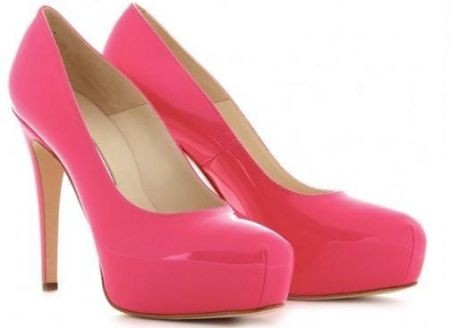 Naturalmente, trattandosi di un breve sondaggio d’opinione e non di una ricerca di mercato, l’indagine consente di individuare le principali direttrici attorno alle quali ruotano le scelte degli acquirenti in termini di priorità, ma non ha alcuna pretesa di ‘spiegare’ il processo d’acquisto tout court, che è sempre la risultante di un insieme complesso di fattori.
Naturalmente, trattandosi di un breve sondaggio d’opinione e non di una ricerca di mercato, l’indagine consente di individuare le principali direttrici attorno alle quali ruotano le scelte degli acquirenti in termini di priorità, ma non ha alcuna pretesa di ‘spiegare’ il processo d’acquisto tout court, che è sempre la risultante di un insieme complesso di fattori.
Ci siamo quindi limitati a lavorare su alcuni elementi di base: quello della quantità rispetto alla qualità e quello della qualità rispetto al prezzo e rispetto alla moda. Ecco cosa ne è emerso.
Per la maggior parte degli italiani – quasi due terzi – ‘è meglio comprare poche cose ma buone e che durino nel tempo’, piuttosto che rinnovare continuamente il guardaroba con indumenti e scarpe di minor valore, filosofia abbracciata da circa un quarto del campione. Una minoranza composta in percentuali superiori al dato medio da donne, giovani e soggetti che avvertono qualche difficoltà economica.
Tra qualità e quantità, dunque, gli italiani scelgono l’investimento nella qualità, confermando le tendenze registrate da altri recenti studi sull’argomento, che parlano di un consumatore sempre più consapevole e informato, sempre più sensibile al tema della qualità.
E d’altra parte anche quando si introducono nella scelta fattori importanti quali il prezzo o la moda, la qualità continua a rimanere in testa alle priorità degli italiani, raccogliendo il 56% delle preferenze. Naturalmente, in questo caso, il vantaggio segnato dalla qualità si riduce, poiché il costo gioca un ruolo di primaria importanza per un terzo del campione e la moda per un intervistato su dieci (più attenti alle ultime tendenze soprattutto i giovani).
Invitiamo, tuttavia, a leggere con cautela questo dato, poiché – ribadiamo – il processo d’acquisto è sempre frutto di una combinazione di fattori, tra i quali, ad esempio, il ‘binomio’ qualità-prezzo (ovvero il fattore convenienza) gioca sempre un ruolo fondamentale; mentre in questo caso i rispondenti venivano ‘forzati’ ad esprimere un’unica preferenza. Per questa ragione, se da un lato i risultati sono particolarmente significativi, in quanto identificano il criterio ‘primo e fondamentale’ di scelta dei consumatori, dall’altro sono in qualche misura riduttivi, perché impossibilitati a cogliere il peso reale dei fattori ‘concorrenti’ alla scelta. Per esempio, è assai probabile che il fattore moda, in questo caso, risulti molto schiacciato dal peso preponderante della qualità e del prezzo, ma che nella realtà giochi un ruolo ben più significativo…
Inoltre, non va dimenticato che il termine ‘qualità’ rappresenta un concetto alquanto aleatorio, al quale ciascuno di noi attribuisce una connotazione differente, che può celare aspettative di valore molto diverse.
Nell’interpretazione di questi dati, dunque, può risultare particolarmente utile l’analisi ‘combinata’ delle due domande poste al campione, che consente di segmentare gli intervistati per stili di consumo, tenendo conto dell’influenza di almeno due fattori nella scelta d’acquisto.
I risultati di tale segmentazione confermano la presenza di un segmento cospicuo e maggioritario di soggetti che mettono al primo posto la qualità, ma ci permette anche di osservare altre linee di pensiero, rappresentate da ulteriori cinque target. Vediamoli tutti:
1. I QUALITATIVI PURI (52%) – si tratta del segmento che mette la qualità al centro delle proprie scelte d’acquisto; un target che può ancora contare su un discreto potere d’acquisto e che quindi può permettersi di spendere un po’ di più, per garantirsi lo stesso volume d’acquisti di prima, senza rinunciare alla qualità.
2. I TRENDY (10%) – si tratta del segmento che mette la moda al centro delle proprie scelte d’acquisto e per il quale l’investimento in abbigliamento riveste un ruolo di primaria importanza: non a caso oggi questi soggetti comprano e spendono più di prima. Un target che nel suo complesso presenta una netta prevalenza femminile e giovanile. Al suo interno, tuttavia sono ravvisabili due sottoinsiemi, che rimandano all’approccio più quantitativo o qualitativo all’acquisto, e con esso – probabilmente - ad una diversa scelta di ‘marca’:
I griffati (6%) – ovvero quelli che preferiscono comprare meno ‘pezzi’ purché siano quelli desiderati; che sfruttano molto le occasioni offerte dai saldi, prediligendo gli acquisti fatti nei negozi cittadini, e dagli outlet, dove riescono a fare una serie di affari;
I modaioli (4%) – ovvero quelli che desiderano avere un guardaroba pieno di abiti in linea con le ultime tendenze, ma che presentano un profilo d’acquisto più ‘pop’, frequentando maggiormente centri commerciali e grandi magazzini.
3. GLI AMBIGUI (6%) – è un target dai tratti apparentemente contraddittori: sostengono di scegliere in base alla qualità ma fanno fatica a rinunciare alla quantità; questo dovrebbe portarli a spendere molto di più, invece stanno spendendo di meno, pur mantenendo lo stesso volume d’acquisti. Sono un target economicamente in bilico: diviso tra quanti ancora riescono a vivere tranquillamente e quanti invece cominciano ad avvertire difficoltà economiche. Per questo utilizzano molto i saldi, preferendo acquistare nei centri commerciali e nei grandi magazzini.
4. I RISPARMIATORI (17%) – ovvero quelli che, a causa di qualche difficoltà economica, stanno cercando di tagliare il budget dedicato all’abbigliamento senza ridurre eccessivamente il numero degli acquisti; probabilmente, pur di risparmiare, accettano qualche compromesso in più sulla qualità e sfruttano molto i saldi, sia d’estate che d’inverno, tendendo ad evitare i negozi cittadini.
5. GLI AUSTERI (15%) – un target più anziano, composto da quei soggetti meno interessati all’abbigliamento che, a fronte delle loro crescenti difficoltà economiche, tendono a comprare e spendere meno, selezionando attentamente gli acquisti in una logica di convenienza dell’investimento: poche cose ma buone, all’insegna del risparmio.
Tendenza al risparmio: utilizzo dei saldi Oltre 6 italiani su 10 aspettano i saldi per fare gli acquisti più importanti, il più delle volte sia per i capi invernali che per gli estivi. Si tratta di una tendenza abbastanza trasversale al campione, che si accentua lievemente tra quanti avvertono difficoltà economiche e tra i residenti al Sud. Difficile individuare delle vere e proprie preferenze sui punti vendita: circa 3 italiani su 10 comprano dove capita, la restante parte si divide tra i negozi – quelli presenti in città soffrono sempre di più la concorrenza di quelli presenti nei centri commerciali – e, in seconda battuta, tra grandi magazzini e outlet.
FONTE:
Soggetto realizzatore: Publica ReS Srl
Committente e acquirente: Confesercenti Nazionale
Data di esecuzione dal 17/03/2008 al 19/03/2008
Tipo di rilevazione; sondaggio telefonico CATI e online CAWI su un campione stratificato per quote di 800 soggetti rappresentativi dell’universo di maggiorenni residenti in Italia.
Tutti i parametri sono uniformati ai più recenti dati forniti dall'ISTAT. I dati sono stati ponderati al fine di garantire la rappresentatività rispetto ai parametri di zona, sesso ed età.
Margine d’errore massimo: ± 3,7%
Il mercato del retail nei paesi del Golfo Persico (2008)
Il retail, uno dei mercati più importanti nelle economie dei paesi del Golfo Persico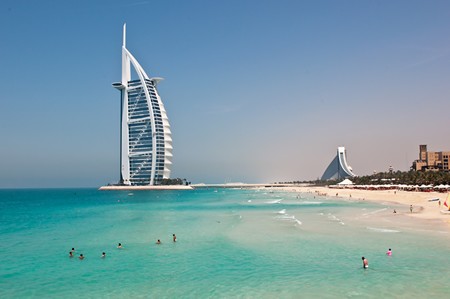 Il retail è uno dei mercati più importanti nelle economie dei paesi del Golfo Persico e la superficie del territorio adibita alle varie proprietà commerciali comprende circa 6 milioni di metri quadrati con una crescita elevatissima, basti pensare che nel 1990 la superficie adibita era solo di un milione di metri quadrati. In termini di densità, lo spazio retail nella capitale Doha ammonta a circa 600/700 metri quadrati ogni 1000 persone, numero questo che si prevede in forte crescita negli anni a venire con lo sviluppo di diversi progetti. Si pensa che si raggiungeranno i 600mila metri quadrati di superficie adibito ad esercizi commerciali. In questi 600mila metri quadrati è compreso anche un vasto investimento di circa 2.5 bn (billioni di dollari) per la realizzazione di un'isola artificiale, adesso ancora in fase di sviluppo. La Perla, questo sarà il nome di quest’isola, sarà uno dei più grandi progetti nella regione e solo lei offrirà circa 200mila metri quadrati di spazio retail. Anche altri membri della GCC entreranno nel mercato del Qatar, per esempio Emke Group di Abu Dhabi, gruppo che sta realizzando un nuovo centro commerciale a Al Khor. Costo stimato circa 138milioni di dollari, e si pensa che sarà completato nei prossimi 18 mesi. Il PIL in Qatar si trova attualmente ad oltre di 52 bn (bilioni di dollari) e con le attuali iniziative del governo, la cifra è destinata a crescere a più di 70 bilioni di dollari entro la fine del 2008. Il reddito pro capite del Qatar è uno dei più alti del mondo, e si prevede una crescita più di 68 mila dollari entro il 2008, in base ai dati rilasciati dalla Banca nazionale di Qatar. Con il crescente potere d’acquisto, il Qatar ha dimostrato più e più volte di essere agli acquisti di lusso. I progetti come la Perla hanno l’obiettivo di portare nel mercato i marchi e gruppi internazionali più importanti per stabilizzare e ottimizzare la crescita della nazione. Come la perla, la maggior parte dei prossimi progetti retail in tutta la regione, riguarderanno i beni di lusso e mercati “higher-end”. Lagoona Mall, in fase di sviluppo da Darwish Holding a Doha nella prestigiosa West Bay Lagoon, sorgerà su 75.000 metri quadrati per clienti “high-end”. Per soddisfare una piccola ma ricca popolazione, molte aziende hanno scelto dei volumi quantitativi relativamente bassi ma di qualità molto elevata. "La parola d’ordine per i paesi del Golfo Persico è l’esclusività più di ogni altra cosa” Najarian Nazar, direttore generale di Luxury retail Modern Home, ha detto alla OBG. "Il prezzo è importante, in quanto il mercato in genere aspetta sempre i prodotti più costosi, ma l’esclusività è la chiave vera - indipendentemente dal prezzo". Con il potere d’acquisto in aumento, generalmente superiore rispetto alla media del reddito disponibile, i rivenditori, i retailers e i proprietari dei centri commerciali stanno cercando dei rendimenti ulteriori come potenziali paraurti. Non si tratta solo quelli direttamente coinvolti con il settore, ma la crescita del retail e una maggiore concorrenza, sono viste di buon occhio per l'intera economia.
Il retail è uno dei mercati più importanti nelle economie dei paesi del Golfo Persico e la superficie del territorio adibita alle varie proprietà commerciali comprende circa 6 milioni di metri quadrati con una crescita elevatissima, basti pensare che nel 1990 la superficie adibita era solo di un milione di metri quadrati. In termini di densità, lo spazio retail nella capitale Doha ammonta a circa 600/700 metri quadrati ogni 1000 persone, numero questo che si prevede in forte crescita negli anni a venire con lo sviluppo di diversi progetti. Si pensa che si raggiungeranno i 600mila metri quadrati di superficie adibito ad esercizi commerciali. In questi 600mila metri quadrati è compreso anche un vasto investimento di circa 2.5 bn (billioni di dollari) per la realizzazione di un'isola artificiale, adesso ancora in fase di sviluppo. La Perla, questo sarà il nome di quest’isola, sarà uno dei più grandi progetti nella regione e solo lei offrirà circa 200mila metri quadrati di spazio retail. Anche altri membri della GCC entreranno nel mercato del Qatar, per esempio Emke Group di Abu Dhabi, gruppo che sta realizzando un nuovo centro commerciale a Al Khor. Costo stimato circa 138milioni di dollari, e si pensa che sarà completato nei prossimi 18 mesi. Il PIL in Qatar si trova attualmente ad oltre di 52 bn (bilioni di dollari) e con le attuali iniziative del governo, la cifra è destinata a crescere a più di 70 bilioni di dollari entro la fine del 2008. Il reddito pro capite del Qatar è uno dei più alti del mondo, e si prevede una crescita più di 68 mila dollari entro il 2008, in base ai dati rilasciati dalla Banca nazionale di Qatar. Con il crescente potere d’acquisto, il Qatar ha dimostrato più e più volte di essere agli acquisti di lusso. I progetti come la Perla hanno l’obiettivo di portare nel mercato i marchi e gruppi internazionali più importanti per stabilizzare e ottimizzare la crescita della nazione. Come la perla, la maggior parte dei prossimi progetti retail in tutta la regione, riguarderanno i beni di lusso e mercati “higher-end”. Lagoona Mall, in fase di sviluppo da Darwish Holding a Doha nella prestigiosa West Bay Lagoon, sorgerà su 75.000 metri quadrati per clienti “high-end”. Per soddisfare una piccola ma ricca popolazione, molte aziende hanno scelto dei volumi quantitativi relativamente bassi ma di qualità molto elevata. "La parola d’ordine per i paesi del Golfo Persico è l’esclusività più di ogni altra cosa” Najarian Nazar, direttore generale di Luxury retail Modern Home, ha detto alla OBG. "Il prezzo è importante, in quanto il mercato in genere aspetta sempre i prodotti più costosi, ma l’esclusività è la chiave vera - indipendentemente dal prezzo". Con il potere d’acquisto in aumento, generalmente superiore rispetto alla media del reddito disponibile, i rivenditori, i retailers e i proprietari dei centri commerciali stanno cercando dei rendimenti ulteriori come potenziali paraurti. Non si tratta solo quelli direttamente coinvolti con il settore, ma la crescita del retail e una maggiore concorrenza, sono viste di buon occhio per l'intera economia.
To learn more: This email address is being protected from spambots. You need JavaScript enabled to view it.
Relazione dell’ associazione del franchising russo per il Consiglio Mondiale del franchising
 E’ possibile oggi parlare di un boom del franchising in Russia?
E’ possibile oggi parlare di un boom del franchising in Russia?
Molte società e imprenditori russi stanno scegliendo la formula in franchising per creare una rete di imprese che vadano ad incidere sullo sviluppo nazionale. Il mercato russo è diventato molto interessante anche per possibili partners internazionali, perché oltre ad essere un mercato in crescita è riuscito a sensibilizzare anche i propri consumatori ormai in una situazione di benessere generale.
Osservazione del fatturato del mercato Retail nel 2007.
Il fatturato mensile del retail ha superato un trilione di rubli mentre il tasso di crescita del Retail è cresciuto fino a 15,6%. Nei prossimi anni, secondo le stime degli analisti il mercato russo diventerà uno dei più grandi e sviluppati d’ Europa. Prendendo in considerazione circa 85 milioni tra consumatori e clienti russi, il reddito reale dei russi aumenterà dell’ 8.10% annuo.
Dal punto di vista delle società straniere un mercato come quello russo diventerà in breve tempo la prima scelta per la ricerca sia di clienti che di nuovi partners. Prendendo in considerazione alcuni rischi tipici per la Russia, il modo migliore per iniziare un’ attività è creare un partnership con una società affidabile russa. Proprio per questo motivo il franchising è una forma efficace per stabilire questi tipi di rapporti.
Negli ultimi dieci anni il mercato russo ha assistito la creazione e lo sviluppo dinamico di una serie di aziende conosciute in tutto il mondo come ad esempio:”Sbarro” “Subway”, “Masterfibre”, “Hirsh”, “Grillmaster”, “Ekonika”, “Enton”, “Kopeyka" e molti altri.
Questa enorme crescita può essere giustificata anche grazie all’apporto di know how che ha portato la comunità imprenditoriale russa.
Di seguito si può vedere il crescente sviluppo del franchising nel mercato russo dal 1995 al 2007.
La quantità dei nuovi sistemi di franchising avviati ogni anno nel mercato russo durante il periodo dal 1995 fino al 2007
 Come indicato sul diagramma, solo 8 franchising hanno iniziato la propria attività durante i primi 2 anni di sviluppo del franchising russo. Poi negli anni seguenti il numero dei franchisor è aumentato notevolmente. La crisi finanziaria russa nel 1998 ha influenzato le dinamiche di crescita dei franchising molto negativamente. Tuttavia, dopo il 1998 la stabilità della crescita dei sistemi franchising è stata rinnovata. Nel 2007 sono entrati 27 nuovi franchising e abbiamo tutti i motivi di credere che lo sviluppo del franchising russo continuerà nel suo sviluppo. Il diagramma della crescita dei sistemi franchising dal 1995 al 2007, viene visualizzato sul grafico presentato qui di seguito. Il grafico mostra l'accelerazione dinamica della quantità di franchisor che sono sorti in Russia.
Come indicato sul diagramma, solo 8 franchising hanno iniziato la propria attività durante i primi 2 anni di sviluppo del franchising russo. Poi negli anni seguenti il numero dei franchisor è aumentato notevolmente. La crisi finanziaria russa nel 1998 ha influenzato le dinamiche di crescita dei franchising molto negativamente. Tuttavia, dopo il 1998 la stabilità della crescita dei sistemi franchising è stata rinnovata. Nel 2007 sono entrati 27 nuovi franchising e abbiamo tutti i motivi di credere che lo sviluppo del franchising russo continuerà nel suo sviluppo. Il diagramma della crescita dei sistemi franchising dal 1995 al 2007, viene visualizzato sul grafico presentato qui di seguito. Il grafico mostra l'accelerazione dinamica della quantità di franchisor che sono sorti in Russia.
La crescente quantità dei nuovi sistemi franchising.
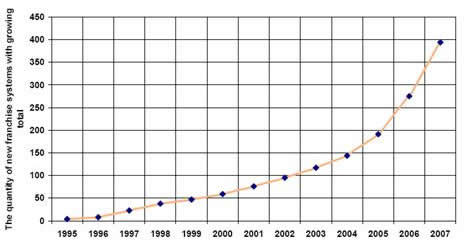
Capitolo 54 «concessione commerciale» del Codice Civile della Federazione Russa regolamenta il franchising in Russia. Secondo il capitolo # 54 il franchising è chiamato "L'accordo del concessione commerciale" franchisor sono chiamati "right-holders" e affiliati
sono chiamati "Users"
La segmentazione dei sistemi franchising sui tipi di attività in Russia è indicato nel diagramma presentato qui sotto. Attività di retailing, compresi i diversi tipi di "convenience stores, abbigliamento e calzature, ecc prende il primo posto (48%). Il settore alimentare (ristoranti, fast food, ecc) prende il secondo posto.
1. Retailing
2. alimentari (ristoranti,fast food, ecc)
3. Servizi per le persone (“every day” e altri servizi)
4. Intrattenimento, viaggiare, sport
5. servizi Business
6. formazione
7. servizi sanitari
8. Servizi automobilistici
9. servizi Costruzione
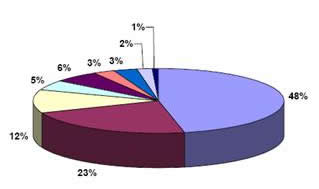
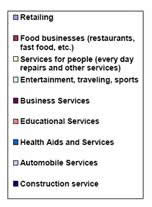
L’ associazione franchising russa è stata costituita nel 1997 come organizzazione non-profit - per sostenere e proteggere le esigenze dei suoi membri e per creare maggiori condizioni di espansione del franchising in Russia. L'Associazione è stata costruita per contribuire agli interessi dei suoi membri, fornire informazioni sulla diffusione del franchising, servire le persone che lavorano in questo settore.
L’ ASSOCIAZIONE svolge le seguenti attività:
• fornire formazione nel settore management, fornire l'opportunità di usare la relativa documentazione del settore e dare un introduttiva consulenza;
• fornire assistenza agli attuali e potenziali utenti con materie di ricerca scientifica, questioni connesse alla creazione di imprese, norme giuridiche, ricerche di mercato e di finanziamento;
• diffondere materiale sulla teoria e la pratica del franchising nei mezzi di comunicazione (nei modi stabiliti dalla legislazione);
• organizzare il franchising internazionale, compreso l'adeguamento dei sistemi di franchising stranieri alle condizioni dei mercati locali;
• istituire filiali, divisioni e uffici della rappresentanza dell’ ASSOCIAZIONE all’ estero in base alle rispettive legislazioni;
• eseguire altri tipi di attività non vietati dalla normativa.
Dell’ associazione possono farvi parte franchisor, studi di supporto business, affiliati, fondi non governativi, Master Franchisee, franchisee, banche, società di consulenza e sviluppo, consulenti franchising, avvocati, fornitori e venditori del franchising. Tutti i membri della RFA sono coperti da un Codice Etico e sono tenuti a rispettare i suoi principi. La RFA assiste e consiglia i suoi membri in base al presente codice. RFA agisce come un ponte tra tutte le parti e fornisce un costante forum di informazione e ricerca. I suoi obbiettivi principi sono la promozione, comprensione e lo sviluppo del franchising in Russia e migliorare l’ambiente imprenditoriale e giuridico nel settore franchising. La RFA ha i siti web www.rarf.ru e www.franchisinguniverse.ru I siti sono regolarmente aggiornati e contengono informazioni importanti per gli utenti russi e stranieri.
Inoltre l'Associazione conduce seminari in molte regioni della Russia; dispone le conferenze e prende parte alle mostre ed ad eventi importanti all’ estero, partecipando anche alla fase organizzativa.
Funzioni principali di RFA sono:
1. Impostare ed applicare le norme etiche del business tra i membri
2. Coordinare e offrire i programmi educativi, seminari e mostre appositamente orientate al franchising
3. Intraprendere attività promozionali per promuovere il franchising
4. Fornire collegamento e il dialogo con i dipartimenti governativi
5. Fungere il forum per lo scambio di esperienze e di know-how tra i membri
6. Stabilire e mantenere affiliazioni e leorganizzazioni al livello mondiale
7. Sviluppare e mantenere affiliazioni con “trade industry” locale, rappresentare i distributori, retailers e industria dei servizi in generale.
Il Consiglio di Amministrazione è costituito da almeno 5 (cinque) membri che fanno parte dei maggiori franchisor. La composizione del Consiglio di Amministrazione è determinato da una votazione annuale dell’ ASSOCIAZIONE per un periodo di 2 (due) anni. Ogni membro dell’ Associazione può nominare i candidati tra i membri al consiglio di amministrazione.
Ogni membro dell’ ASSOCIAZIONE deve seguire la normativa del Codice Etico. Nel caso in cui la RFA riceva informazioni su una possibile violazione del codice da parte dei suoi membri, il Consiglio d’ Amministrazione è tenuto ad esigere che il dato membro
dell’ ASSOCIAZIONE presenti informazioni che attestino l’osservazione di tutte le leggi che regolano il Codice Etico.
Ogni membro dell' associazione può appartenere a una delle seguenti categorie:
• Franchisor - Right-holder con un contratto di concessione commerciale
• Franchisee - User under con un contratto di concessione
• Fornitore – consulente industriale / fornitore dei servizi
• Altre categorie
Dal 2007 i membri dell' associazione appartengono a una delle seguenti categorie:
• Franchisor - Right-holder con un contratto di concessione commerciale (76%);
• Fornitore – consulente industriale / fornitore dei servizi(24%).
Il Consiglio d’ Amministrazione procede alla ripartizione dei suoi membri tra le suddette corrispondenti categorie. Tutti i membri delle categorie devono avere pari diritti nella votazione.
Il consiglio di Amministrazione fissa l'importo della quota associativa annuale per ogni categoria.
Come indicato sul diagramma presentato sotto, l’adesione al RFA è in crescita.
La quantità di RFA membri dal 1997 fino al 2007
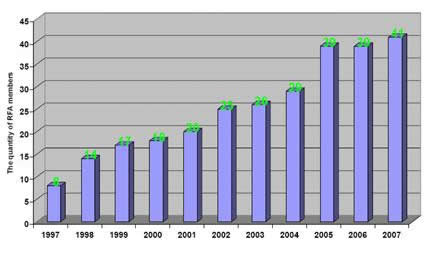
RFA la Sede:
Shosse Entuziastov, 56, Str. 32, off. 482,
Moscow, 111123, Russia.
Tel./Fax: (495) 780 5150
E-mail: This email address is being protected from spambots. You need JavaScript enabled to view it.
http://www.rarf.ru and http://www.franchisinguniverse.ru
Potete trovare sul nostro Web http://www.rarf.ru/eng/ i seguenti materiali:
• gli articoli dell’ associazione
• Il Codice Etico di RFA
• Codice Civile della Federazione Russa-Capitolo 54
Ricerca di mercato C.C. Caserta (2004)

Download the research: CC Caserta
To learn more: This email address is being protected from spambots. You need JavaScript enabled to view it.
Pop store, temporary & street food










 Il Qatar è uno dei vari emirati sorti nel XX secolo nella penisola arabica, che confina a sud con l'Arabia Saudita ed è per il resto circondato dal golfo Arabico.
Il Qatar è uno dei vari emirati sorti nel XX secolo nella penisola arabica, che confina a sud con l'Arabia Saudita ed è per il resto circondato dal golfo Arabico. Si sta sviluppando in un momento in cui la concorrenza non è ancora così aggressiva e difficilmente affrontabile come negli altri Paesi del MEG.
Si sta sviluppando in un momento in cui la concorrenza non è ancora così aggressiva e difficilmente affrontabile come negli altri Paesi del MEG.

 Il General Manager di ObiettivoQatar, Laura Bertuccioli, sostiene che il Qatar è un Paese che muta il proprio skyline con una rapidità incredibile e, a riprova del suo sviluppo, è un Paese che ha saputo mettere a frutto le proprie riserve petrolifere a partire dagli anni 60 e che oggi, attraverso tali rendite unite a quelle derivanti dalle forniture di gas, non è minimamente toccato da questa crisi mondiale.
Il General Manager di ObiettivoQatar, Laura Bertuccioli, sostiene che il Qatar è un Paese che muta il proprio skyline con una rapidità incredibile e, a riprova del suo sviluppo, è un Paese che ha saputo mettere a frutto le proprie riserve petrolifere a partire dagli anni 60 e che oggi, attraverso tali rendite unite a quelle derivanti dalle forniture di gas, non è minimamente toccato da questa crisi mondiale. Il Qatar ha grandi risorse economiche ed ambiziosi piani di sviluppo nel territorio e nell’intero Golfo.
Il Qatar ha grandi risorse economiche ed ambiziosi piani di sviluppo nel territorio e nell’intero Golfo.


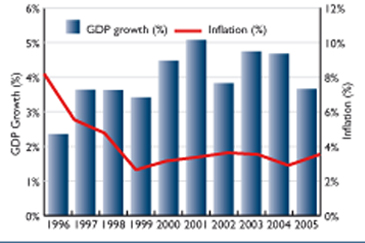
 Current Trends
Current Trends
 Investment
Investment office market is beginning to see primeyields move in, they remain more comparative to Central Eastern markets rather than the Western European core markets and in somecases are now higher than in Central Europe. The is in part due toa weak occupier market and very limited investment stock. Industrial yields have also begin to move in since the end of 2005, although they are not expected to fall dramatically in the short term. Retail yieldshave seen the most downward shift as the market becomes moreattractive to both occupiers and investors and new formats and international retailers show increased levels of interest.Prospects for the market are generally good with further yield compressionexpected as well as rental growth for top end schemes across all sectors.Regional cities may begin to pick up although any growth will bemarginal.
office market is beginning to see primeyields move in, they remain more comparative to Central Eastern markets rather than the Western European core markets and in somecases are now higher than in Central Europe. The is in part due toa weak occupier market and very limited investment stock. Industrial yields have also begin to move in since the end of 2005, although they are not expected to fall dramatically in the short term. Retail yieldshave seen the most downward shift as the market becomes moreattractive to both occupiers and investors and new formats and international retailers show increased levels of interest.Prospects for the market are generally good with further yield compressionexpected as well as rental growth for top end schemes across all sectors.Regional cities may begin to pick up although any growth will bemarginal. 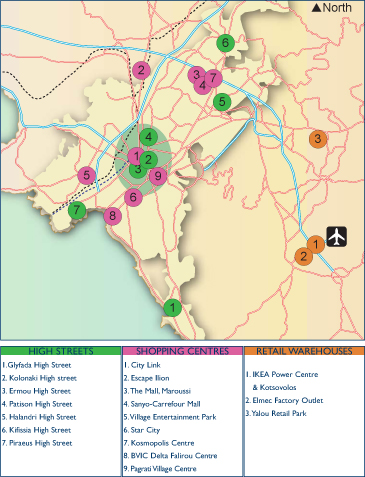

 Since the late 1990s there has been growing interest from both national and international retailers, developers and investors, all lookingfor an opportunity to establish a foothold in the Greek retail scene.Their main focus has been in the shopping centre sector and schemes including leisure activities. Strict planning regulations and bureaucraticprocedures have hampered progress and few modern centres havebeen developed to date, small scale schemes dominating activity.
Since the late 1990s there has been growing interest from both national and international retailers, developers and investors, all lookingfor an opportunity to establish a foothold in the Greek retail scene.Their main focus has been in the shopping centre sector and schemes including leisure activities. Strict planning regulations and bureaucraticprocedures have hampered progress and few modern centres havebeen developed to date, small scale schemes dominating activity.


 As a result of the current immaturity of the retail market, in-townlocations in Athens are still being exploited as shopping centrelocations, in addition to edge and out-of-town developments to servesuburban populations.The Olympic Games was viewed as a catalyst for retail developmentin the country, although several shopping centre schemes scheduled to be open in time for the Games were delayed, with developersfrustrated by often lengthy bureaucratic procedures.However, despite this slow emergence, the shopping centre market is expected to see a strong increase in development in the coming yearsto raise Greece's profile as an international destination for retailersand investors. Indeed while traditional high steet markets will remain competitive, potential for new development exists not only in Athensbut other regional cities as well. Greece has a total of approximately 392,000 sq.m which equates to 37 sq.m per 1,000 inhabitants - a figure closer to the EasternEuropean average of 38 sq.m and significantly lower than the WesternEuropean average of 200 sq.m per 1,000 inhabitants. There is just over 68,000 sq.m of space actually under constructionand a further 277,800 sq.m of proposed space in the pipeline until2009. On the assumption that all the space is brought to the market over the next 3 to 4 years, with consumer spending expected toremain relatively stable over the next twenty-four months, the marketis expected to be able to absorb the schemes will no pressure points of oversupply.
As a result of the current immaturity of the retail market, in-townlocations in Athens are still being exploited as shopping centrelocations, in addition to edge and out-of-town developments to servesuburban populations.The Olympic Games was viewed as a catalyst for retail developmentin the country, although several shopping centre schemes scheduled to be open in time for the Games were delayed, with developersfrustrated by often lengthy bureaucratic procedures.However, despite this slow emergence, the shopping centre market is expected to see a strong increase in development in the coming yearsto raise Greece's profile as an international destination for retailersand investors. Indeed while traditional high steet markets will remain competitive, potential for new development exists not only in Athensbut other regional cities as well. Greece has a total of approximately 392,000 sq.m which equates to 37 sq.m per 1,000 inhabitants - a figure closer to the EasternEuropean average of 38 sq.m and significantly lower than the WesternEuropean average of 200 sq.m per 1,000 inhabitants. There is just over 68,000 sq.m of space actually under constructionand a further 277,800 sq.m of proposed space in the pipeline until2009. On the assumption that all the space is brought to the market over the next 3 to 4 years, with consumer spending expected toremain relatively stable over the next twenty-four months, the marketis expected to be able to absorb the schemes will no pressure points of oversupply.  THE OFFICE MARKET
THE OFFICE MARKET
 Sector Background
Sector Background


 Fashion, luxury and foodstuffs…these are the leading sectors for the diffusion of Italian brands abroad, with expansion systems that are as agile and flexible as franchising. The historical survey of the study centre Luigi Einaudi and Sisim underlines that amongst the most global brands there are, Max Mara, which operates in 61 countries, 3rd behind the French Yves Rocher (in 68 countries) and Lacoste. The first business model for the internationalisation of franchising was implemented by the fashion brands: from simple stylists to multifunctional complex structures, able to integrate the in-house know-how, with the distributors’ and advertisers’ experience.
Fashion, luxury and foodstuffs…these are the leading sectors for the diffusion of Italian brands abroad, with expansion systems that are as agile and flexible as franchising. The historical survey of the study centre Luigi Einaudi and Sisim underlines that amongst the most global brands there are, Max Mara, which operates in 61 countries, 3rd behind the French Yves Rocher (in 68 countries) and Lacoste. The first business model for the internationalisation of franchising was implemented by the fashion brands: from simple stylists to multifunctional complex structures, able to integrate the in-house know-how, with the distributors’ and advertisers’ experience.  "The restorative-gastronomy franchising sector is still in its infancy, however Italian labels and food products are becoming increasingly visible".
"The restorative-gastronomy franchising sector is still in its infancy, however Italian labels and food products are becoming increasingly visible". The share of small enterprises, on average 22.7%, is 40% greater in the wood, leather and shoe industries. Significant quotas, always above 30%, are recorded in the textiles, furniture, clothing, foodstuff and building products industries. In these sectors, SMEs shares have markedly shrunk over the past two years, probably due to a wider exposure to international competition of emerging countries. Amongst the other sectors, only the electrical and electronic equipment sectors have experienced a rise in their shares (almost 2%). As for exports, the most relevant sectors are wood and wood products, where the share of small enterprises (in terms of employees) is above 40%, and the textile, clothing, leather and shoe sectors with shares between 12 and 20%. The strong propensity to internationalisation, therefore, seems to confirm the endeavour of small enterprises in keeping competitiveness in their own sectors of specialisation.
The share of small enterprises, on average 22.7%, is 40% greater in the wood, leather and shoe industries. Significant quotas, always above 30%, are recorded in the textiles, furniture, clothing, foodstuff and building products industries. In these sectors, SMEs shares have markedly shrunk over the past two years, probably due to a wider exposure to international competition of emerging countries. Amongst the other sectors, only the electrical and electronic equipment sectors have experienced a rise in their shares (almost 2%). As for exports, the most relevant sectors are wood and wood products, where the share of small enterprises (in terms of employees) is above 40%, and the textile, clothing, leather and shoe sectors with shares between 12 and 20%. The strong propensity to internationalisation, therefore, seems to confirm the endeavour of small enterprises in keeping competitiveness in their own sectors of specialisation. Quello dell’abbigliamento, dunque, almeno in termini di desiderata, appare un settore la cui domanda interna risulta difficilmente comprimibile.
Quello dell’abbigliamento, dunque, almeno in termini di desiderata, appare un settore la cui domanda interna risulta difficilmente comprimibile.

 Il retail è uno dei mercati più importanti nelle economie dei paesi del Golfo Persico e la superficie del territorio adibita alle varie proprietà commerciali comprende circa 6 milioni di metri quadrati con una crescita elevatissima, basti pensare che nel 1990 la superficie adibita era solo di un milione di metri quadrati.
Il retail è uno dei mercati più importanti nelle economie dei paesi del Golfo Persico e la superficie del territorio adibita alle varie proprietà commerciali comprende circa 6 milioni di metri quadrati con una crescita elevatissima, basti pensare che nel 1990 la superficie adibita era solo di un milione di metri quadrati.  E’ possibile oggi parlare di un boom del franchising in Russia?
E’ possibile oggi parlare di un boom del franchising in Russia?  Come indicato sul diagramma, solo 8 franchising hanno iniziato la propria attività durante i primi 2 anni di sviluppo del franchising russo. Poi negli anni seguenti il numero dei franchisor è aumentato notevolmente. La crisi finanziaria russa nel 1998 ha influenzato le dinamiche di crescita dei franchising molto negativamente. Tuttavia, dopo il 1998 la stabilità della crescita dei sistemi franchising è stata rinnovata. Nel 2007 sono entrati 27 nuovi franchising e abbiamo tutti i motivi di credere che lo sviluppo del franchising russo continuerà nel suo sviluppo. Il diagramma della crescita dei sistemi franchising dal 1995 al 2007, viene visualizzato sul grafico presentato qui di seguito. Il grafico mostra l'accelerazione dinamica della quantità di franchisor che sono sorti in Russia.
Come indicato sul diagramma, solo 8 franchising hanno iniziato la propria attività durante i primi 2 anni di sviluppo del franchising russo. Poi negli anni seguenti il numero dei franchisor è aumentato notevolmente. La crisi finanziaria russa nel 1998 ha influenzato le dinamiche di crescita dei franchising molto negativamente. Tuttavia, dopo il 1998 la stabilità della crescita dei sistemi franchising è stata rinnovata. Nel 2007 sono entrati 27 nuovi franchising e abbiamo tutti i motivi di credere che lo sviluppo del franchising russo continuerà nel suo sviluppo. Il diagramma della crescita dei sistemi franchising dal 1995 al 2007, viene visualizzato sul grafico presentato qui di seguito. Il grafico mostra l'accelerazione dinamica della quantità di franchisor che sono sorti in Russia.




